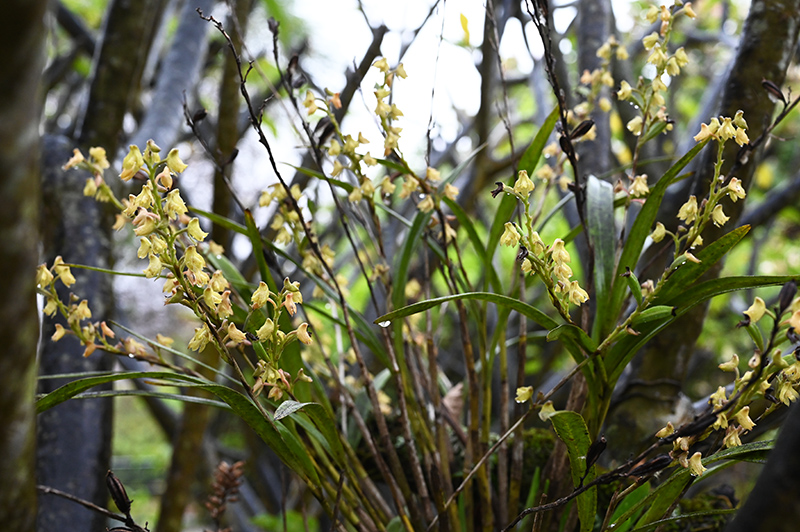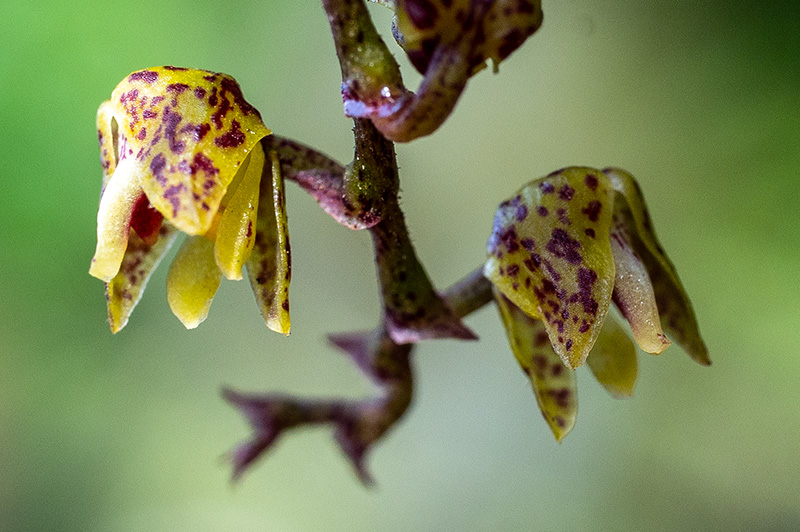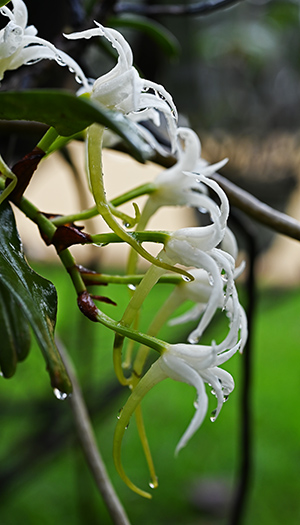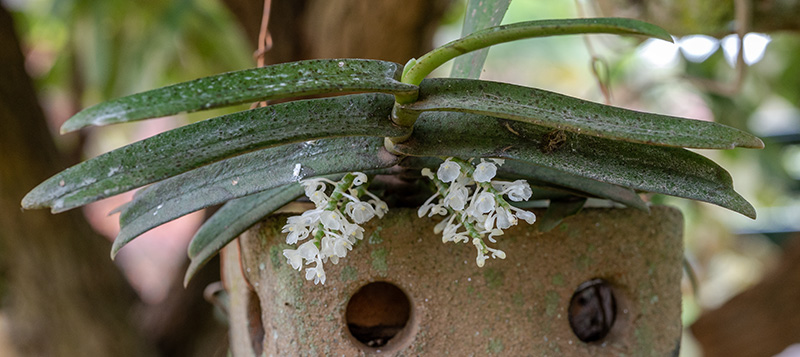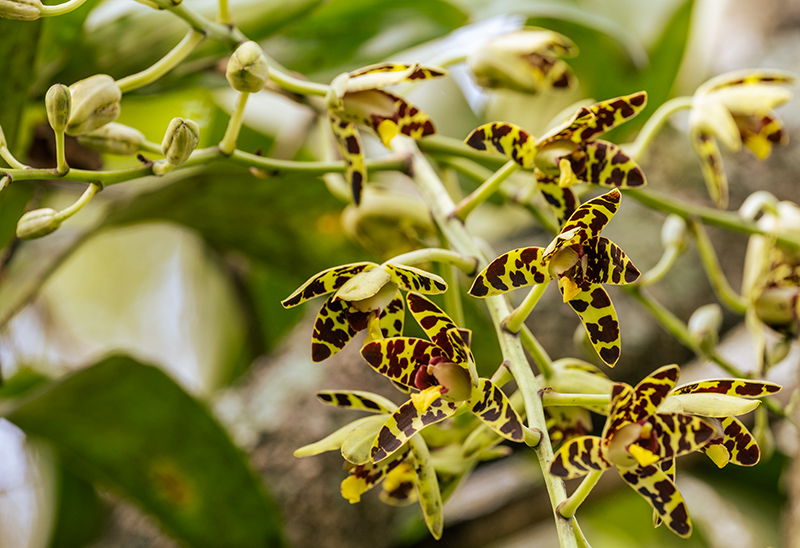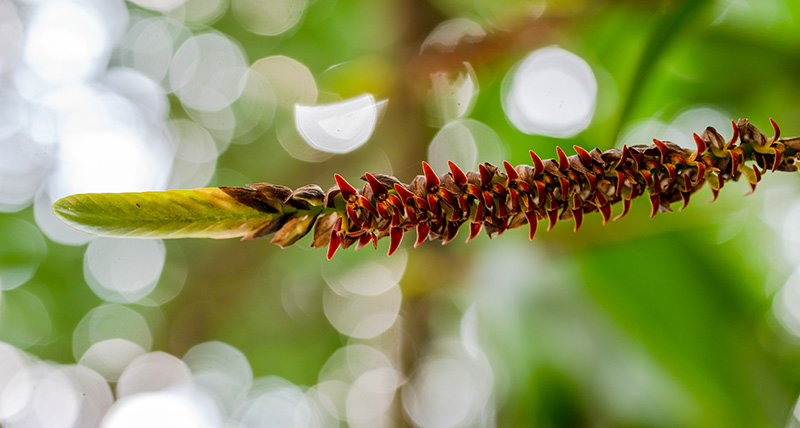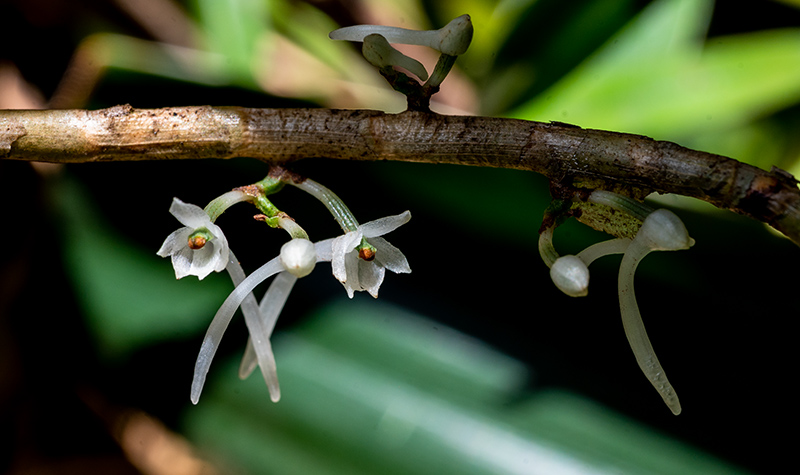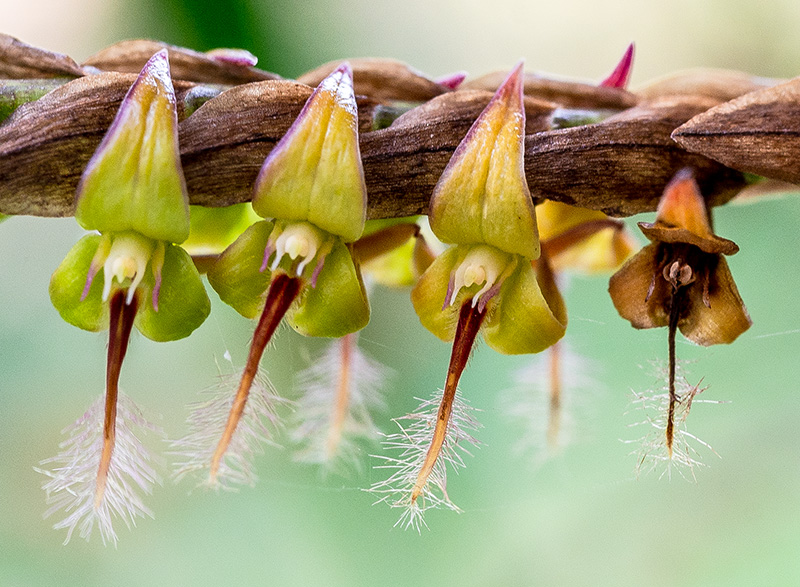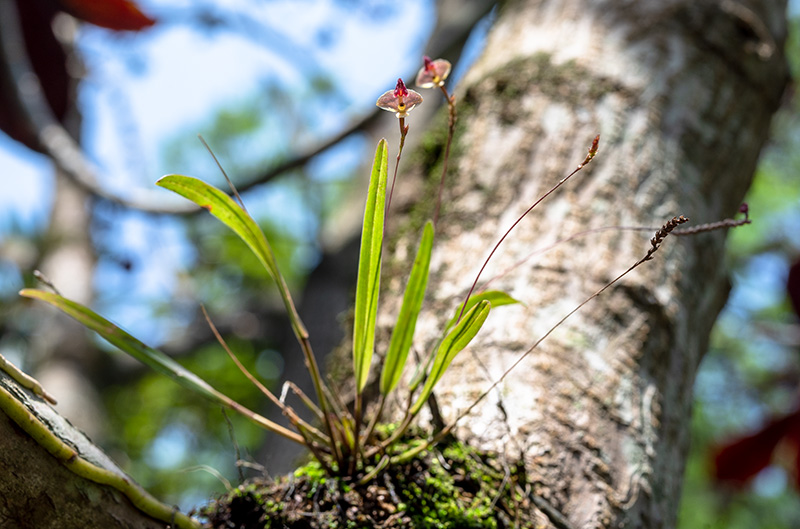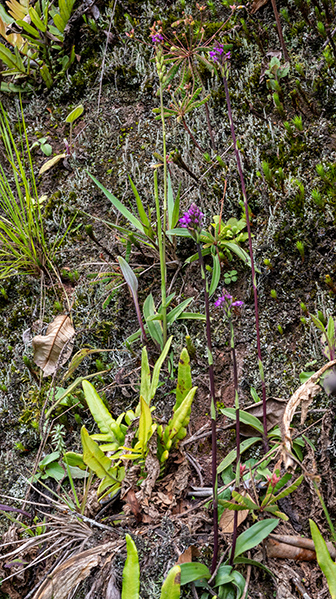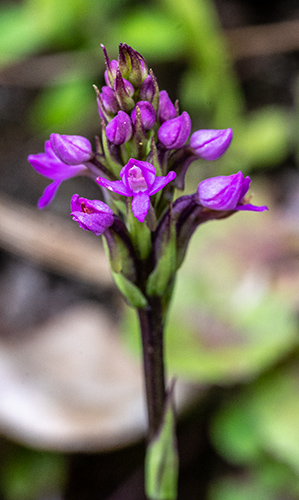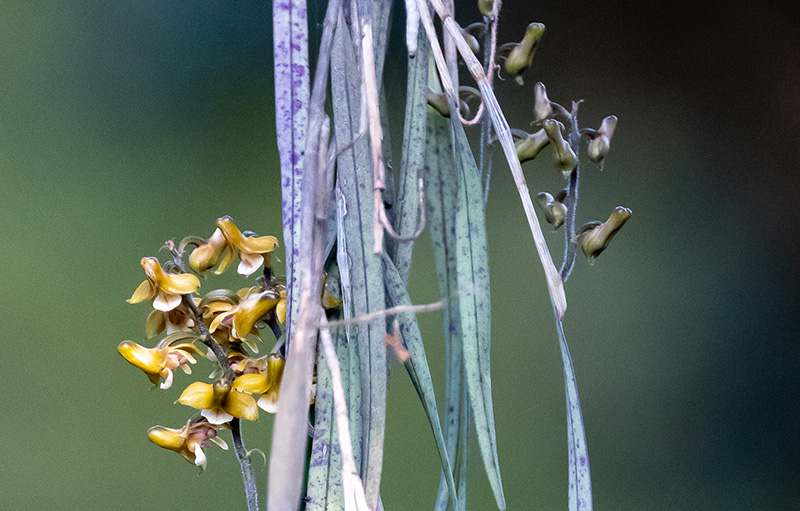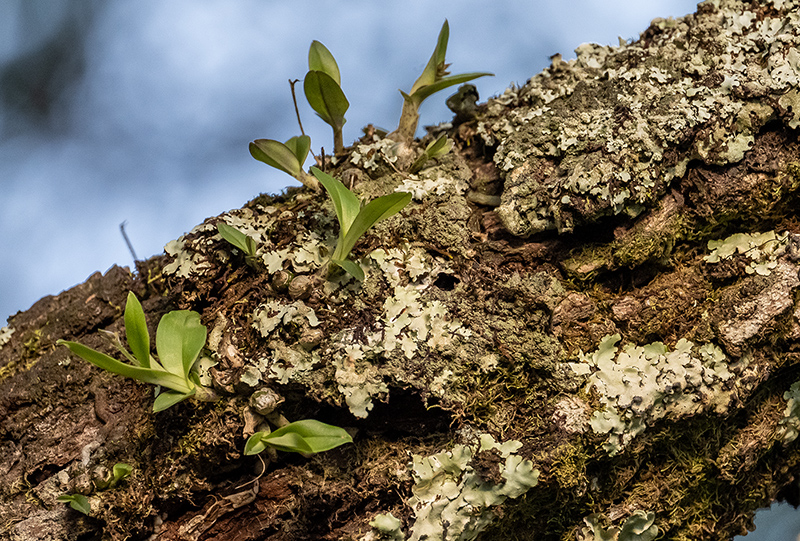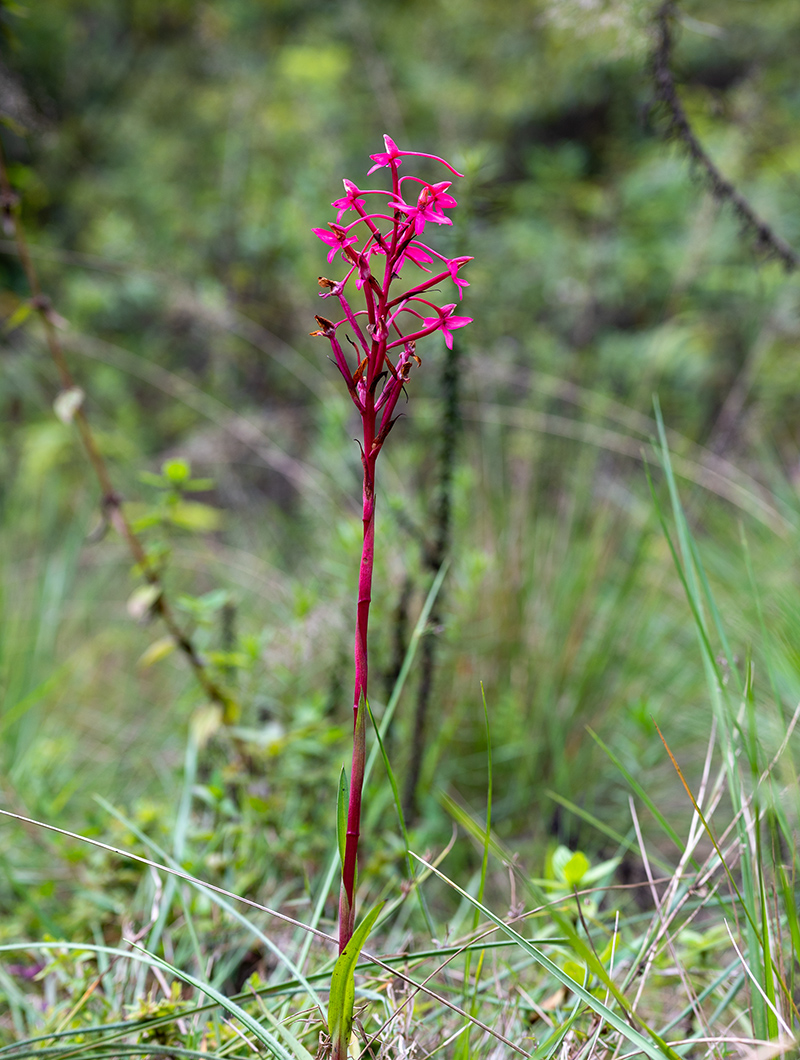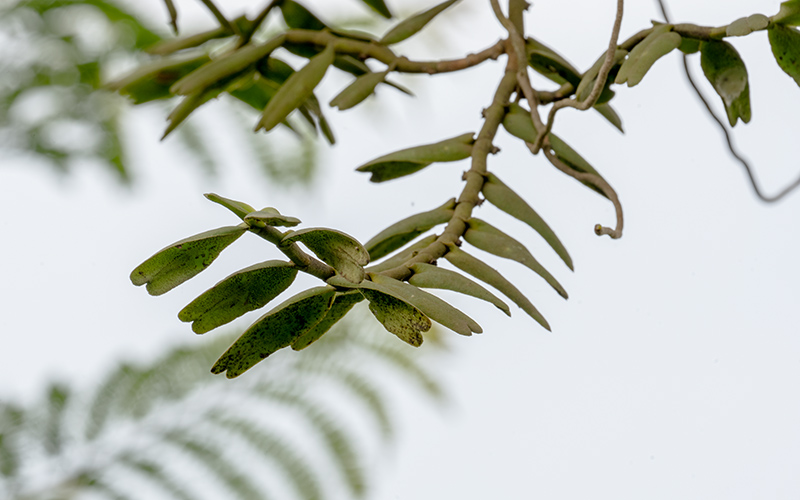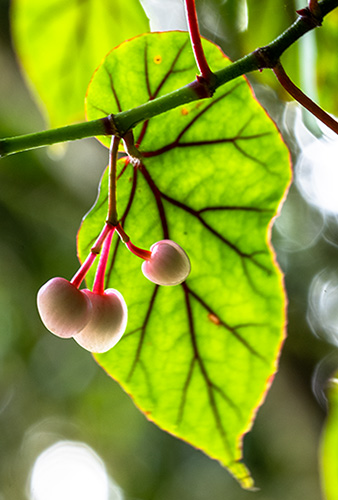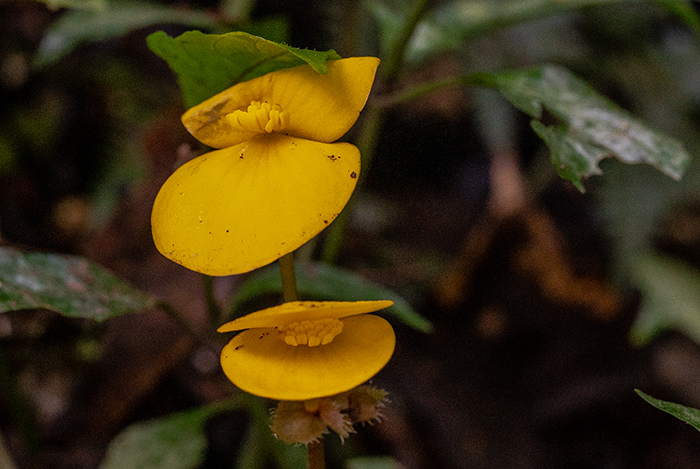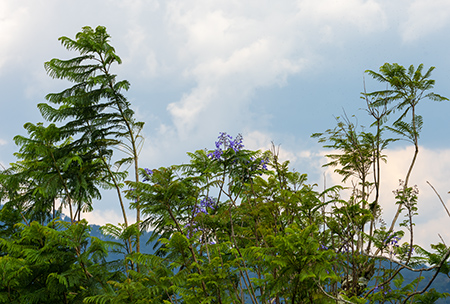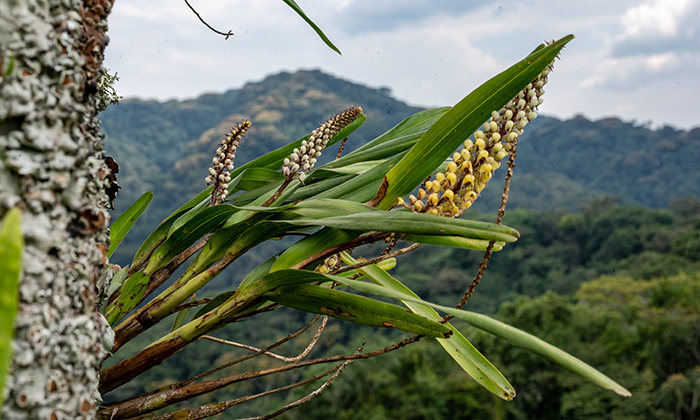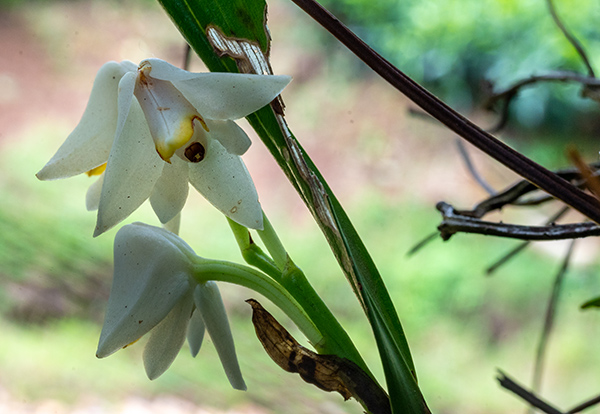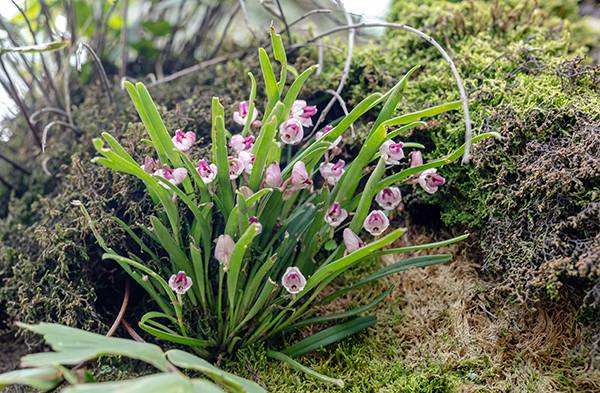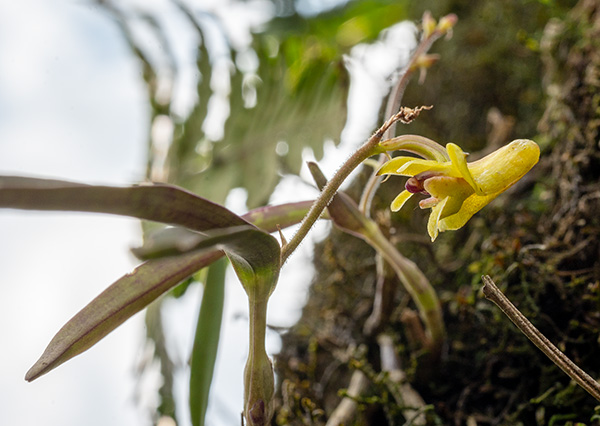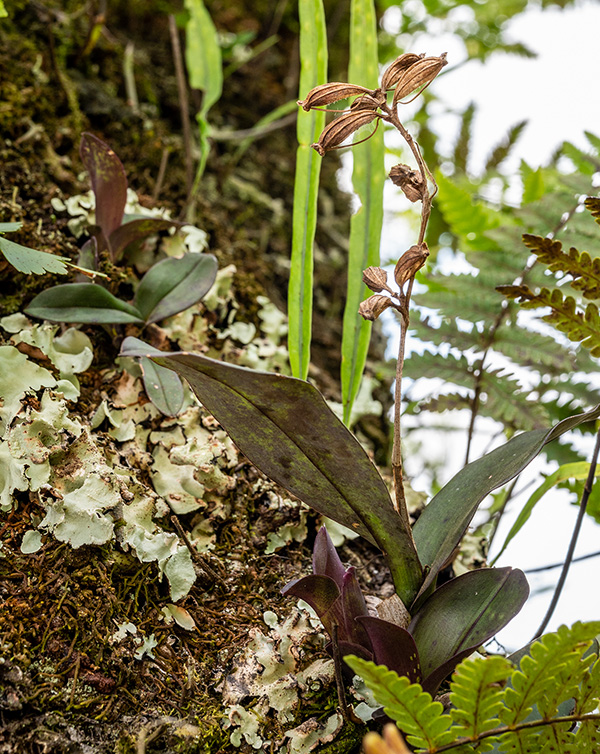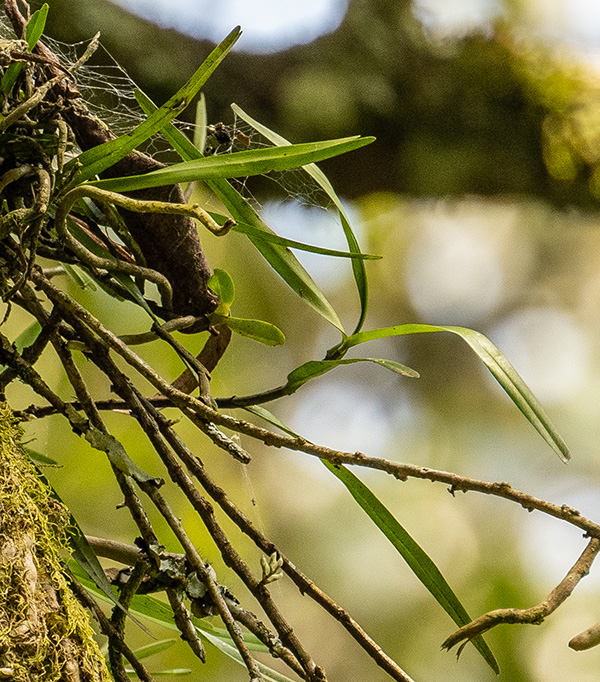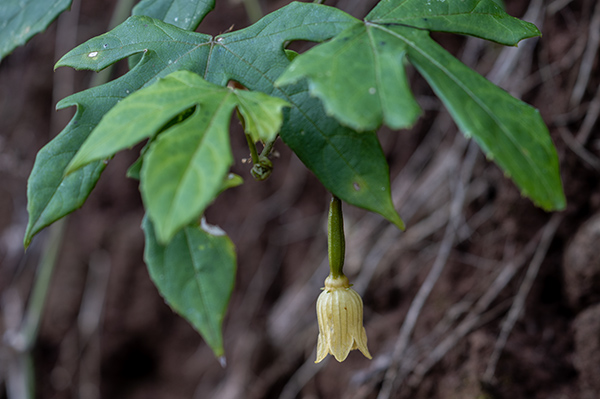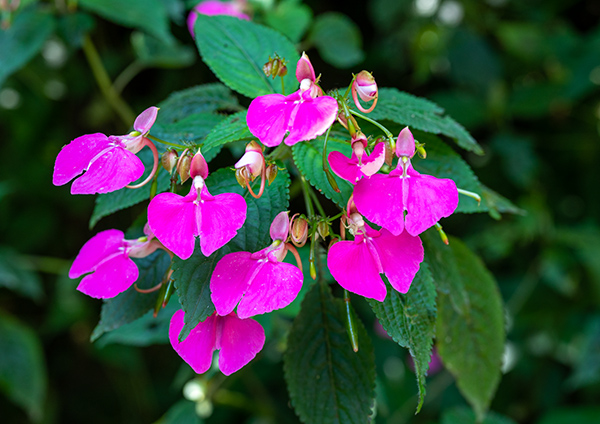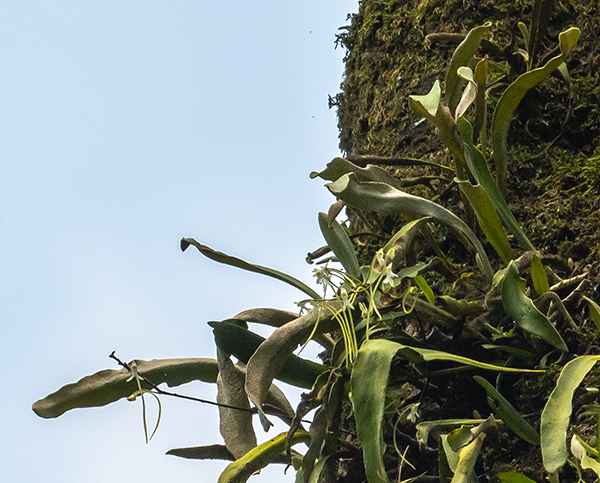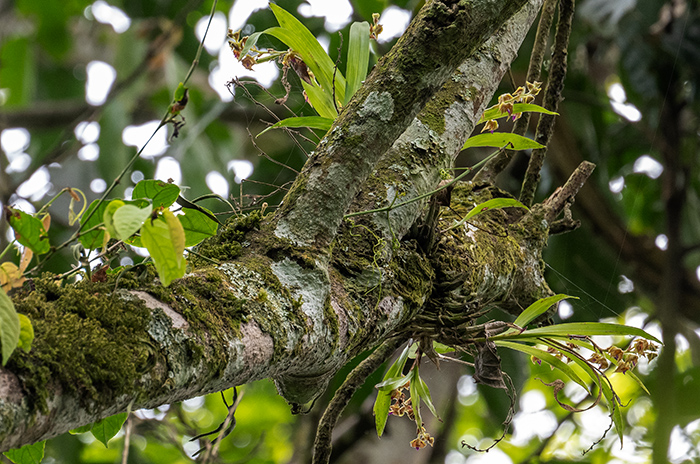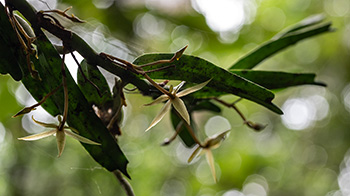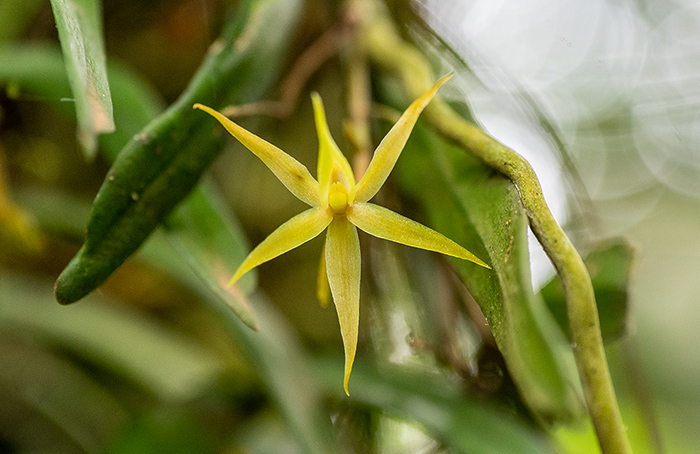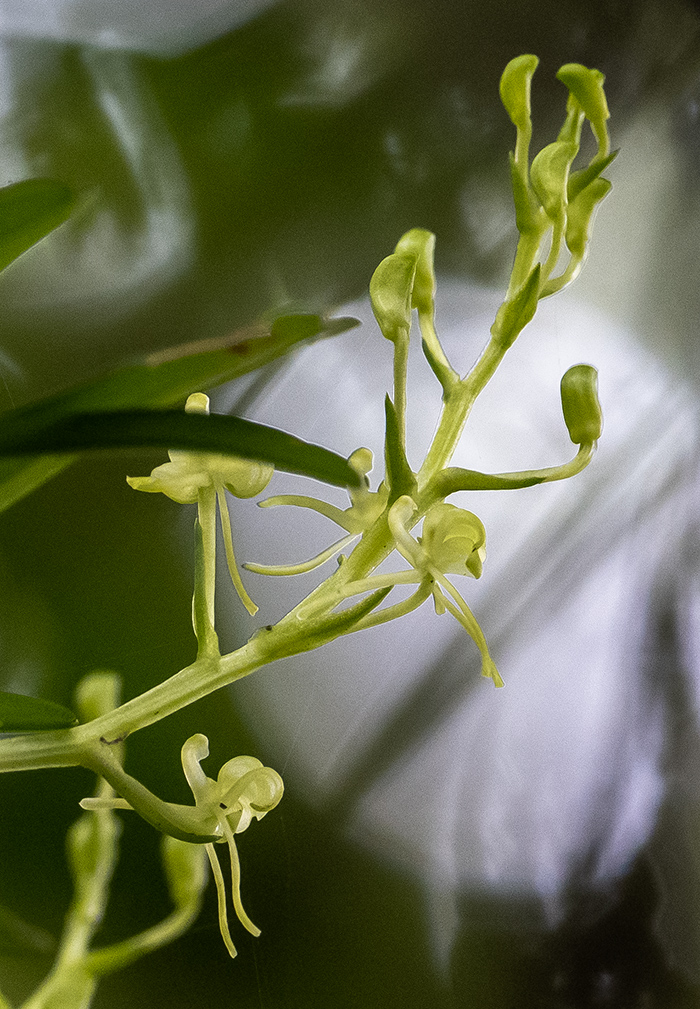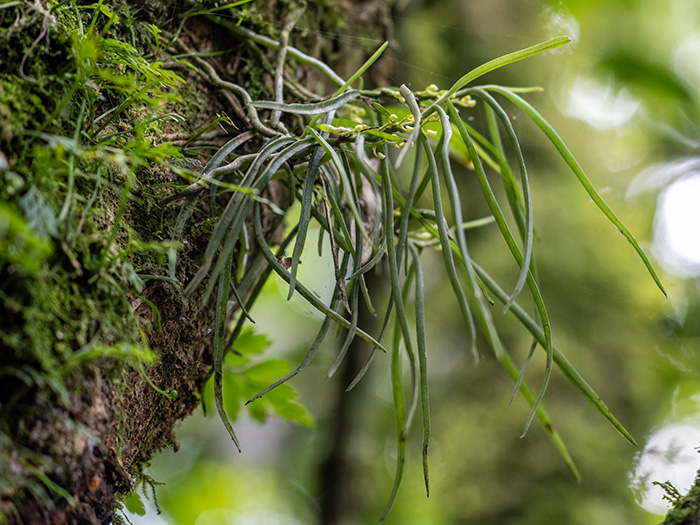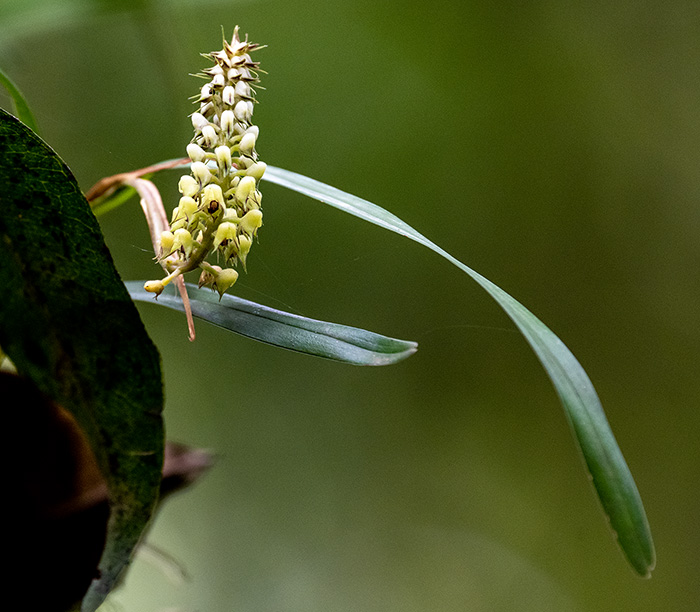In the beginning there was a botanical discovery
Three years after my first botanical trip to Rwanda a botanical discovery takes me to the East African country a second time:
Eberhard Fischer, Dorothee Killmann, Burkhard Leh, and Steven B. Janssens described a new species of mahogany tree in July 2021:
Wohlleben's mahogany (Carapa wohllebenii).
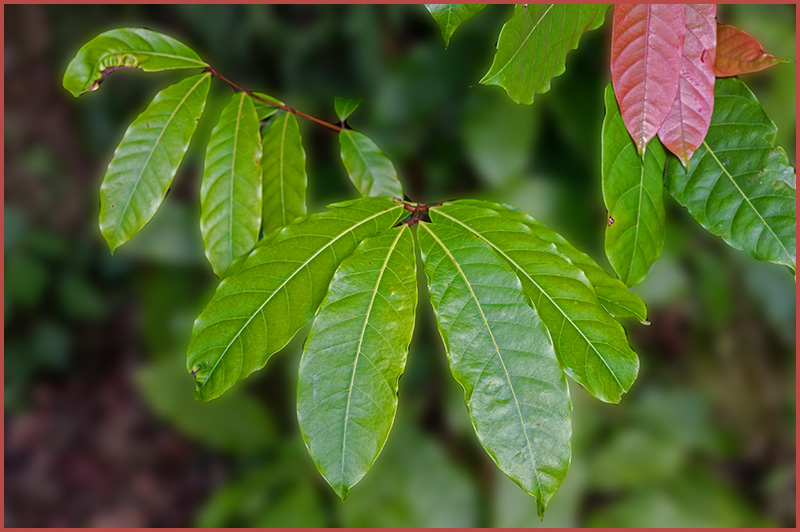
Three researchers at the German university of Koblenz, Eberhard Fischer, Dorothee Killmann and Burkhard Leh, noticed during their studies in the Nungwe rainforest of Rwanda that the mahogany trees there all had pointed leaves. These differed markedly from the rounded deciduous leaves of Carapa grandiflora seen in other forests in the region. A comparison with the type deposited in the herbarium of Kew Gardens near London brought the confirmation: a new tree species!
During the public presentation of Wohlleben's mahogany on 1.10.2021 at the University of Koblenz, the idea arose to show the forester and author Peter Wohlleben the tree named after him on site. And Dorothee suggested me to accompany them. In preparing the trip for September/October 2022, the plan emerged to spend a week on the road with the Wohlleben family and then follow up with a second week for further studies - what a welcome opportunity to deepen my first encounter with tropical orchids in 2018. Even though my Dutch friend Karel Kreutz warned me beforehand: "If you start with tropical orchids too, you're done for."
The following travelogue is organized by regions. It begins with the capital Kigali.
Kigali
The sky above Kigali belongs to the black kites. A large colony of Milvus migrans is greeting us in large colonies right on the evening of our landing on September 24, 2022. And in the morning we can experience the birds of prey at the Urban City Blue hotel, gliding elegantly along. With Tobias Wohlleben, I try to capture the birds in flight - breakfast is no longer important.
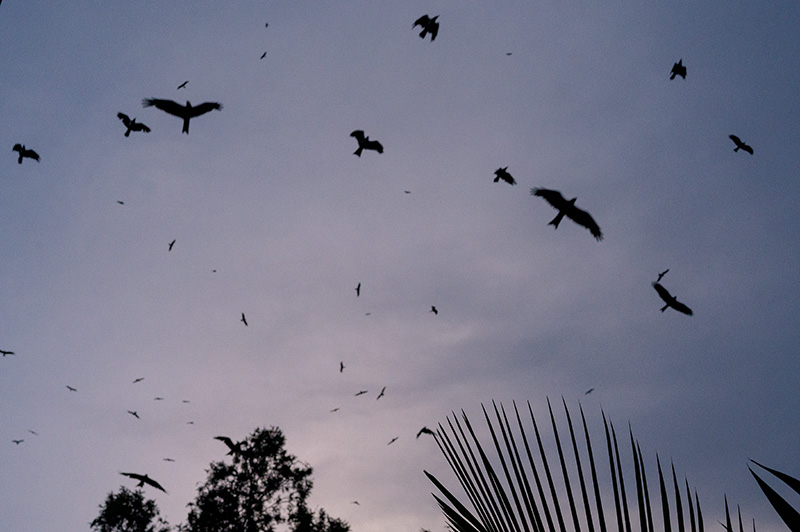
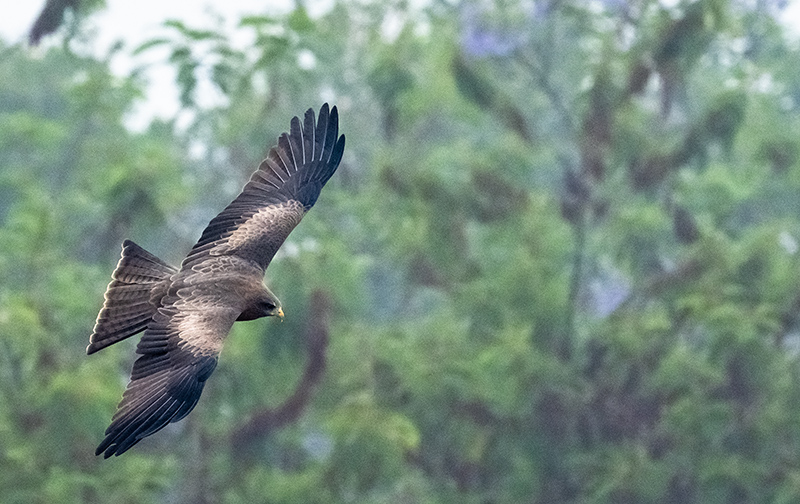

On September 25, we first visit the Kandt House with its memories of the colonial history of Rwanda as well as of first scientific explorations. The house is named after Richard Kandt (1867-1918), who as "Imperial Resident" of Rwanda, part of the colony of German East Africa, chose to reside in Kigali. In 1898, Kandt discovered one of the sources of the Nile in Nyungwe Forest - the research report entitled Caput Nili - a sensitive journey to the sources of the Nile is an interesting read.
Afterwards we are at the Kigali Genocide Memorial, commemorating the victims of the 1994 genocide. So many families are still marked by it today, scarred by trauma. And yet it is amazing how much the country has achieved since then, what joy of life most people radiate.
In a palm tree on the grounds of the memorial, we admire a turaco.
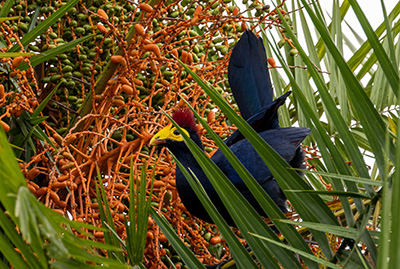
In the orchid garden of Père Jean-Paul
In the afternoon we are with Jean-Paul Lebel, a Canadian priest of the Salesian order and botanist, who has created an impressive orchid collection in the garden of Don Bosco House in Kigali. I had already visited him in 2018. He is co-author of The Orchids of Rwanda, together with Eberhard Fischer, Dorothee Killmann and Gilbert Delepierre. The first edition was published in 2010. Since there are several new orchid species which have been discovered in the meantime, experts are hoping for a second edition.
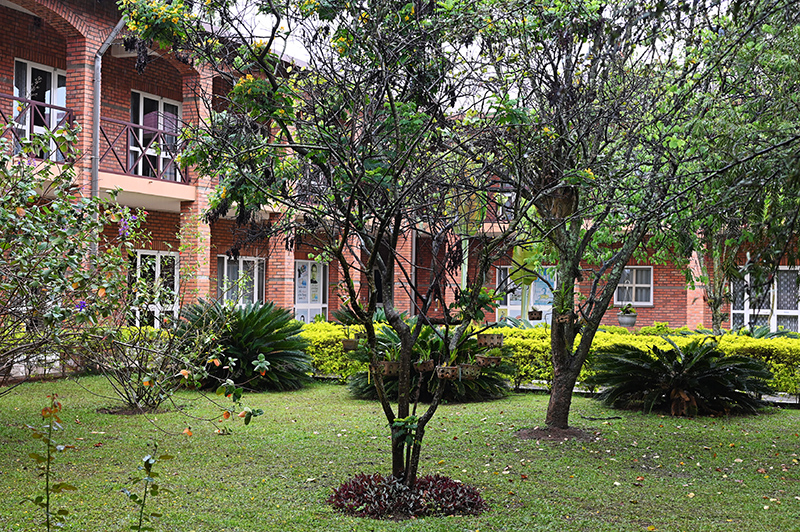
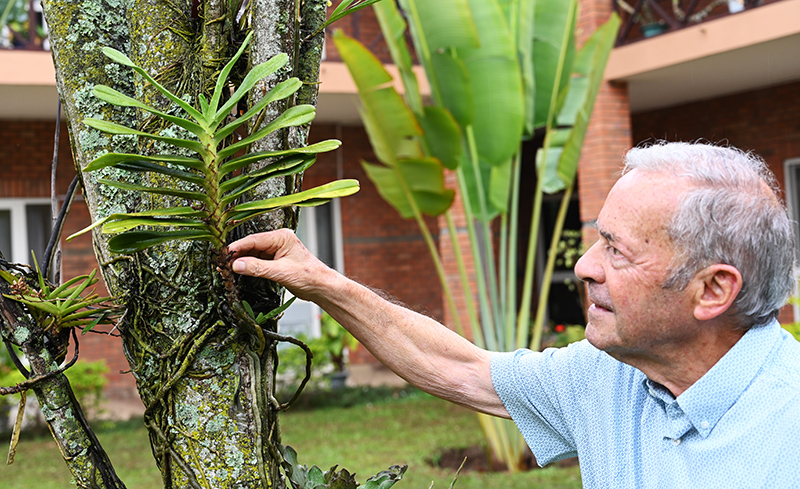
Jean-Paul shows me an orchid, which I can also see later in the rainforest: Aerangis ugandensis is at home in Rwanda, Congo, Kenya and - after all, that's its name - Uganda.
Many flowers has Polystachya benettiana, which grows in the dry savannah in Rwanda, beyond that also in other countries in tropical Africa, from Nigeria to Ethiopia.
The genus Polystachya includes at least 240 species, most of which are native to Africa. What they have in common are the non-resupinated flowers, which means that the flower style does not turn 180 degrees as in most other orchids. With the sepals hanging down, the flowers look like little bells. English botanist William Jackson Hooker (1785-1865) separated the genus as distinct from the genus Dendrobium in his three-volume Exotic Flora (1823-1827):
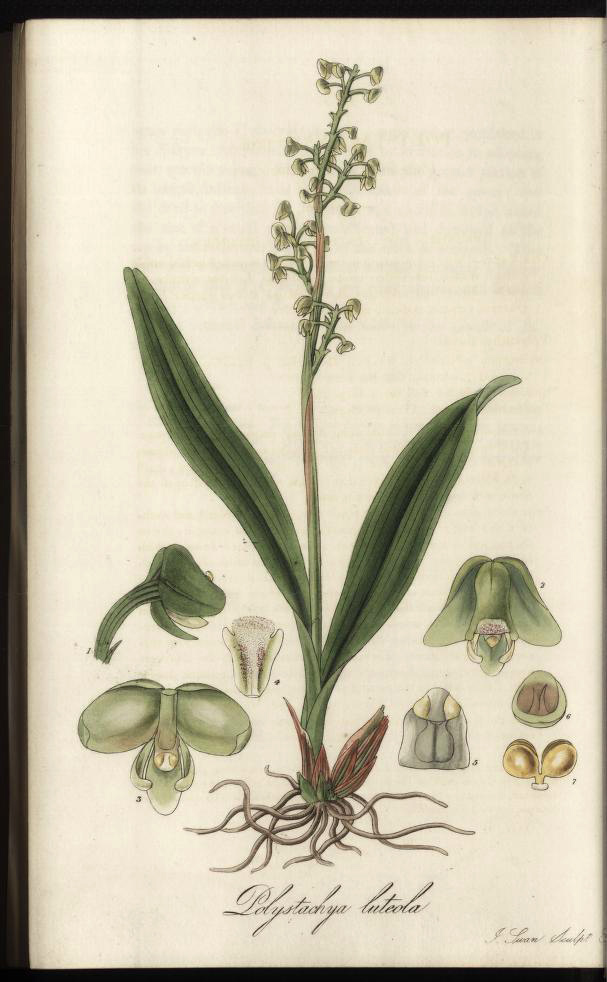
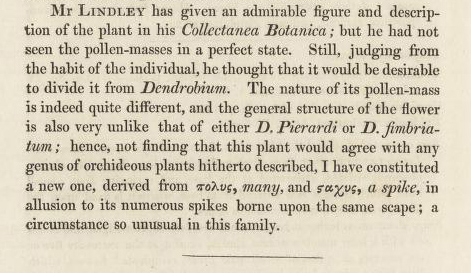
Most of the other Polystachya species in the Don Bosco garden can also be seen in the wild. However, I will not encounter Polystachya pachychila, which grows with its special spotted flowers in the Eastern Congo and Nyungwe forest:
Numerous orchids of other genera also hang from the branches of avocado and other trees. The star-shaped flowering Cyrtorchis arcuata, which actually grows in dry areas, has three sepals and petals of the same shape. The subspecies Cyrtorchis arcuata subsp. whytei, on the other hand, blooms in mountain rainforest, as Jean-Paul explains to me. I admire how, even in his old age, he radiates love for nature, which for him is one with love for God.
A special story is associated with Diaphananthe lebelii, a beautiful orchid with delicate white, almost transparent flowers - named after Jean-Paul Lebel. Eberhard Fischer and Dorothee Killmann described it in 2007 as a new species from the eastern, drier part of the Nyungwe rainforest and classified it in the genus Margelliantha. However, based on new molecular biological findings, João Farminão and others transferred the species to the genus Diaphananthe in 2018.
Adapted to drier locations is Calyptrochilum christyanum, which is already indicated by the thicker leaves. It is represented in the drier locations in the Nyungwe, but is also widespread elsewhere in tropical Africa, between Gambia and Zimbabwe.
When I am at Jean-Paul's for a second time on October 3, Ansellia africana is in most beautiful bloom. Because it hangs high up in a tree, the new telephoto lens is used, with a focal length of up to 400 mm on the Nikon Z 7II I am almost at eye level with the flowers.
On the way a pretty white-browed robin (Cossypha heuglini) hops, Jean-Paul can imitate its call.
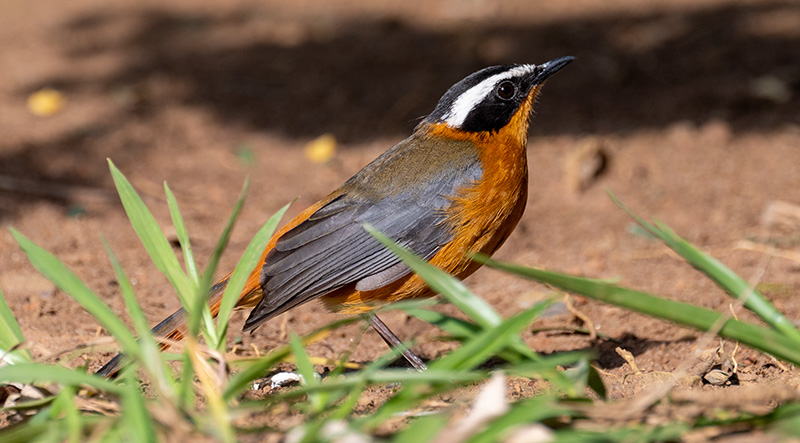
The elongated inflorescence of Bulbophyllum cochleatum var. bequaertii is particularly beautiful. The small flowers of the plant, which is also found in the Nyungwe forest, sit close together. Bulbophyllum is the largest orchid genus with more than 2000 species in South America, Africa and Asia. It is named after the distinctive pseudobulb, from which usually a single leaf sprouts.
Angraecum distichum, which also occurs in Nyungwe, has an elegant leaf structure but is not yet flowering in early October.

L
A trip to the lake
On Saturday, between the two weeks of travel, we go on an excursion to Gashora Lake, to the shore of Hotel Bugesera. With us is Joselyne, whom I met in Kigali in 2018. The approach is not easy over unpaved roads. But finally we reach the hotel with its idyllically situated lakeshore.
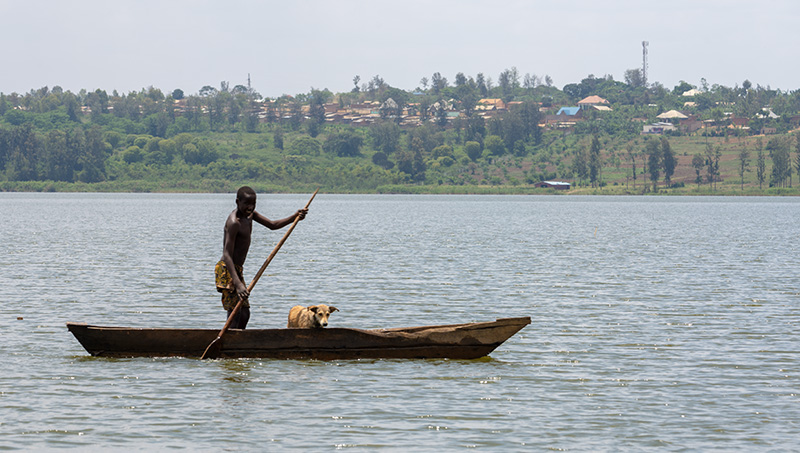
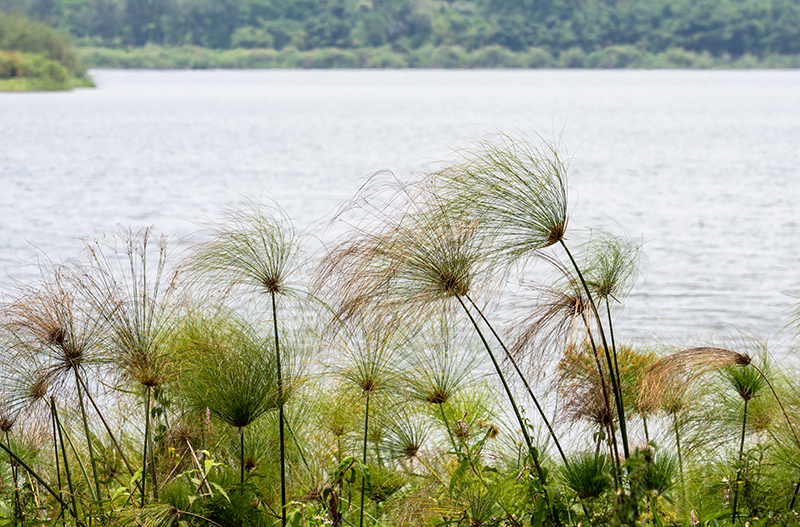
In the water, hippos let themselves drift. But the mighty mammals soon dive down, as the calm is over in preparation for a garden party.
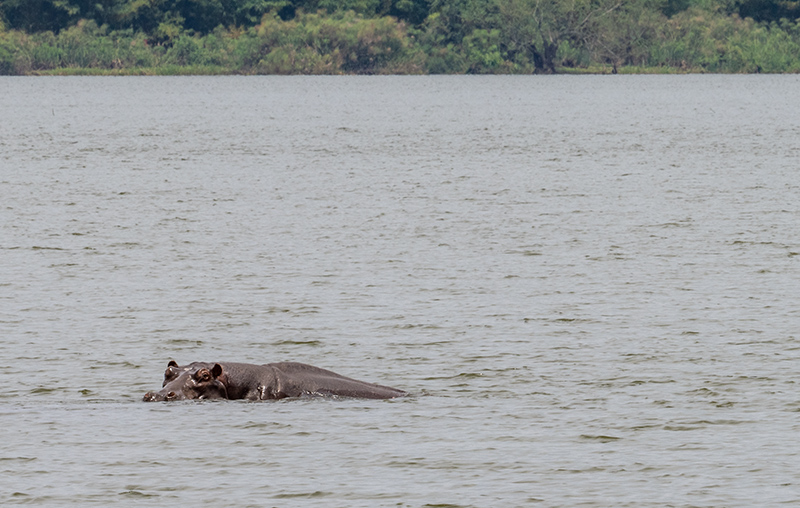
The birds are used to noisy people. In front of the shore, the Pied Kingfisher (Ceryle rudis), looks out for fish before diving into the water.
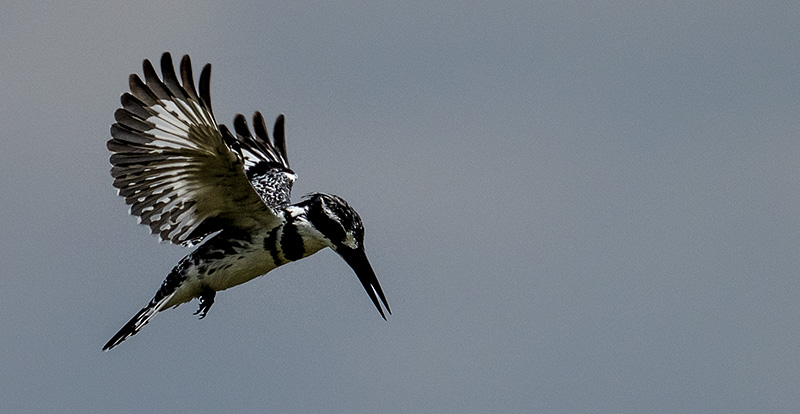
At the edge of the hotel area, another kingfisher species flies from tree to tree, the Woodland Kingfisher (Halcyon senegalensis). It belongs to the subfamily of the tree kingfishers. The breast is pale, the back blue and red, the bill red and black.
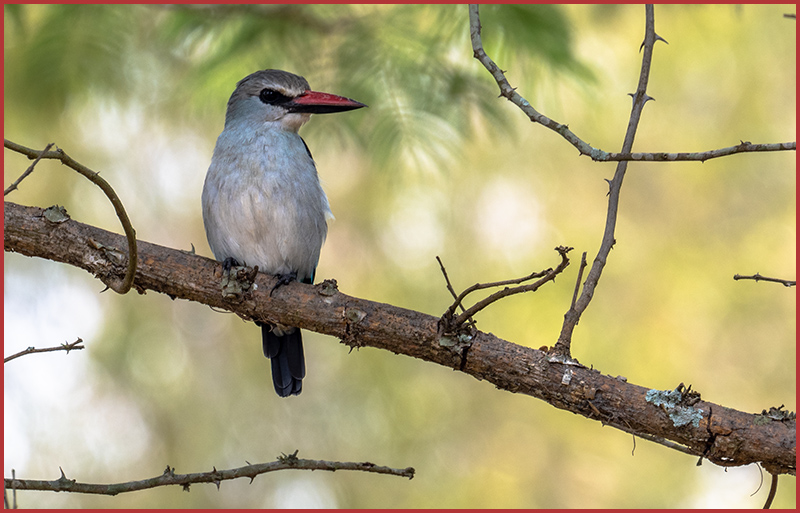
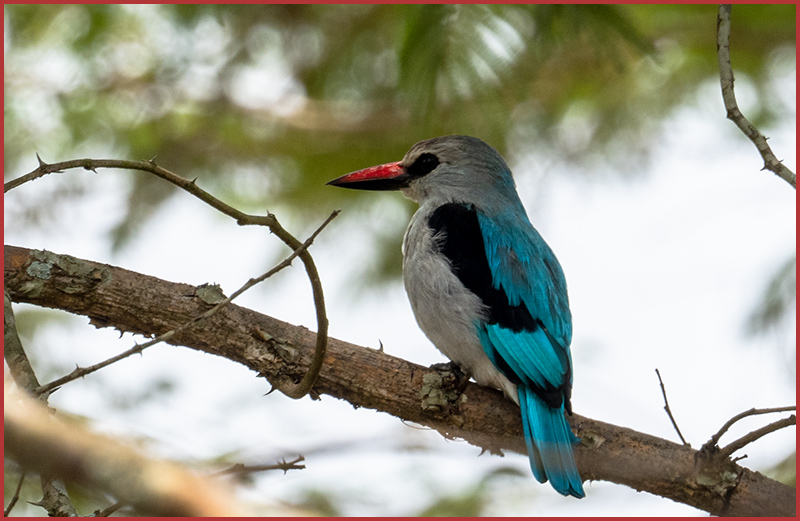
Quite common is the Speckled Mousebird (Colius striatus) with its conspicuous feathered cap. And on a branch persists an ibis, a Hagedash (Bostrychia hagedash).
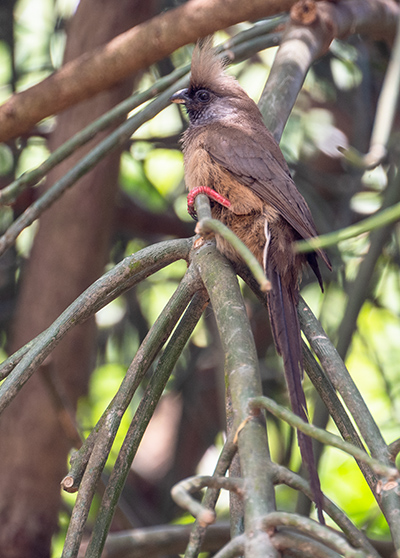
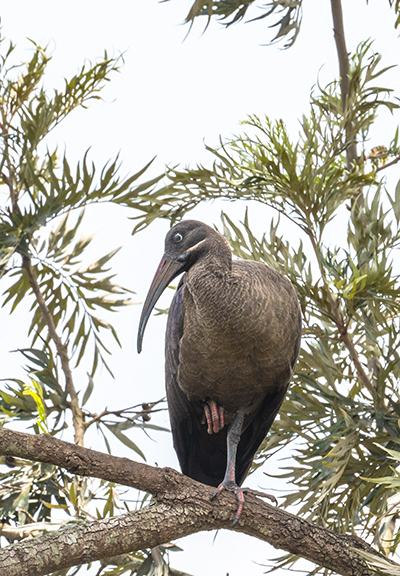
Directly at the shore line a Red-billed Firefinch (Lagonosticta senegala) is cavorting.
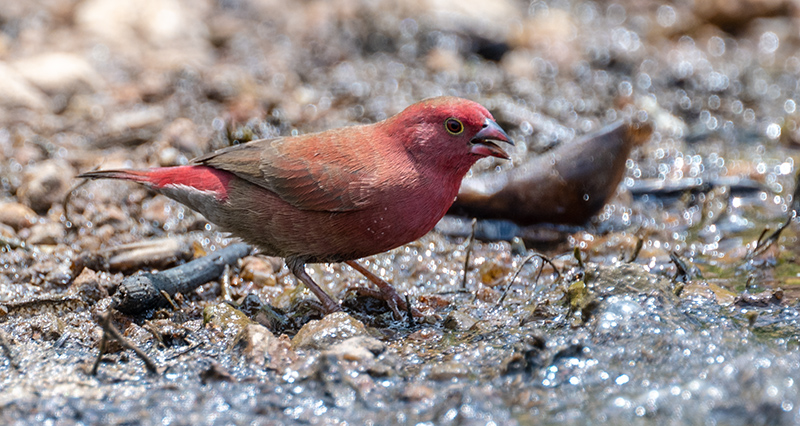
And in the water swims a Little Egret (Egretta garzetta), a true cosmopolitan that has also been sighted in the Westerwald in Germany - so it is fitting that Rhineland-Palatinate and Rwanda are partner countries.
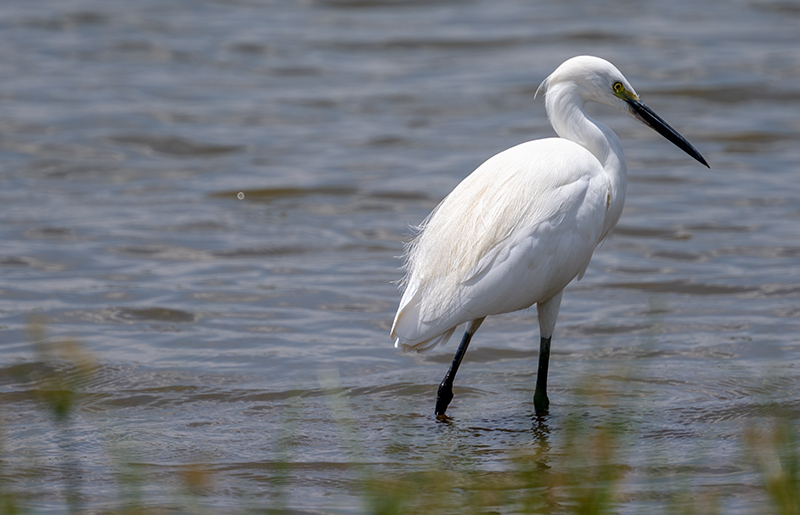
another orchid garden
 On September 26, the road towards Nyungwe leads us first to the city of Butare, in the district of Huye. The German state of Rhineland-Palatinate maintains a research house there. On October 7, we are there a second time on our way back to Kigali. The garden is a small paradise with a bamboo grove and many native trees with orchids growing on their trunks and branches. A hibiscus is also in bloom when we arrive.
On September 26, the road towards Nyungwe leads us first to the city of Butare, in the district of Huye. The German state of Rhineland-Palatinate maintains a research house there. On October 7, we are there a second time on our way back to Kigali. The garden is a small paradise with a bamboo grove and many native trees with orchids growing on their trunks and branches. A hibiscus is also in bloom when we arrive.
I am happy about the second encounter with an orchid of the genus Tridactyle. Three years ago I had seen Tridactyle bicaudata at the edge of Kamiranzovu Swamp in Nyungwe National Park. Here Tridactyle virgula is in bloom. Both have in common that the flowers grow directly from a woody stem. The genus Tridactyle was established in 1915 by Rudolf Schlechter (1872-1925). In his book Die Orchideen, ihre Beschreibung, Kultur und Züchtung (The Orchids, their description, culture and cultivation), he names three orchid species that had previously been considered species of the genus Angraecum, including the then Angraecum bicaudatum. They all form a quite natural genus, easily recognizable by habit alone, Schlechter writes, emphasizing the tripartite lip - hence the name tridactyle - often with split or slit lateral lobes and slender cylindrical spur, never very long. The delicate plants are among my favorite orchids in the African rainforest.
A Bulbophyllum flower amazes with filigree hairs at the end of the lip - Bulbophyllum vulcanicum is an endemic of the African Rift Valley and is at home from eastern Congo via Rwanda to western Uganda.
A particularly beautiful Polystachya shines in the morning backlight in early October: Polystachya dewanckeliana.
In the early morning, however, other beings are also alive.
Breakfast in the Bamboo groove
A family of Vervet monkeys (Chlorocebus) jumps through the garden and feasts on the bamboo leaves. Curiously they look down on me.
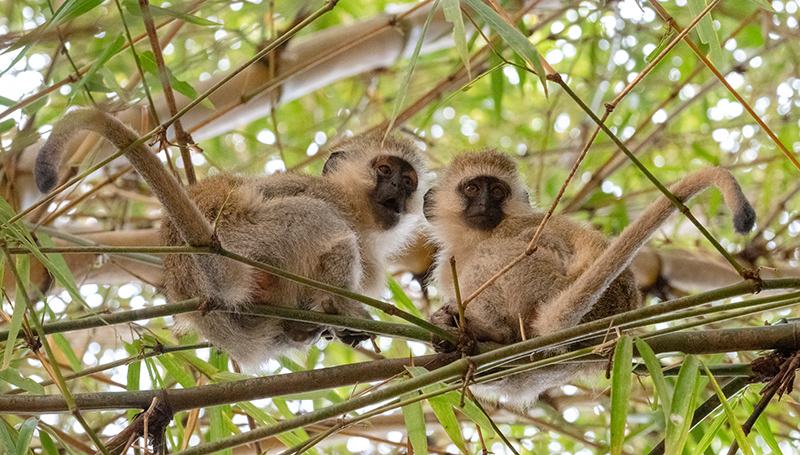
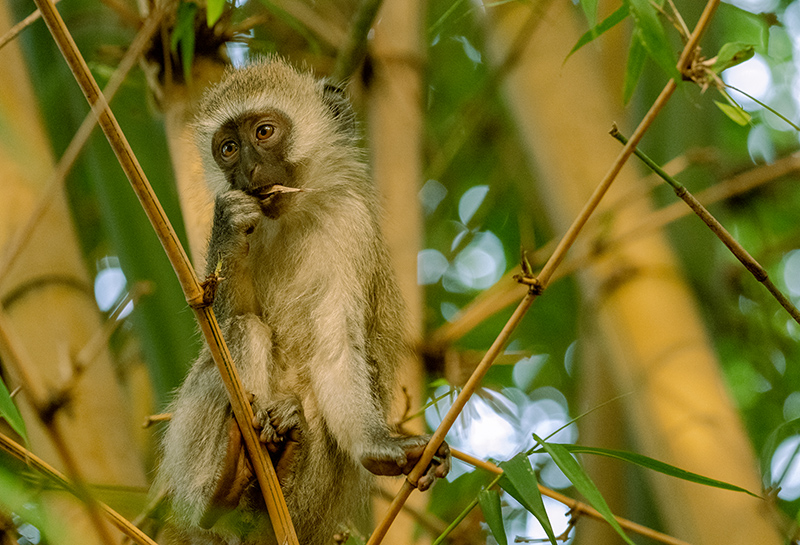
The Nyungwe is a tropical mountain rainforest on the watershed between the Nile and the Congo. It is part of the African Rift Valley, the Albertine Rift, between Lake Albert, Lake Kivu and Lake Tanganjika. On an area of 970 square kilometers, 220 orchid species have been found in the Nyungwe so far, says Eberhard Fischer - in total, more than 1500 vascular plants have been identified there so far. But there are probably even more. Because up to now only about ten percent of the area is accessible with trails, around 90 percent of the Nyungwe forest is still unexplored.

Uwinka
After the stopover in Butare, we row the eastern entrance to Nyungwe in the early afternoon of our second day in Rwanda, September 26, 2022. Dorothee exclaims enthusiastically: What a forest, what trees! From one kilometer to the next, the mountain slopes in the Land of 1000 Hills, as Rwanda is called, are suddenly no longer populated, there are no houses along the road. Instead, the evergreen rainforest stretches endlessly to the horizon. We make our first roadside stop at the Uwasenkoko Swamp, which is crossed by a small stream.
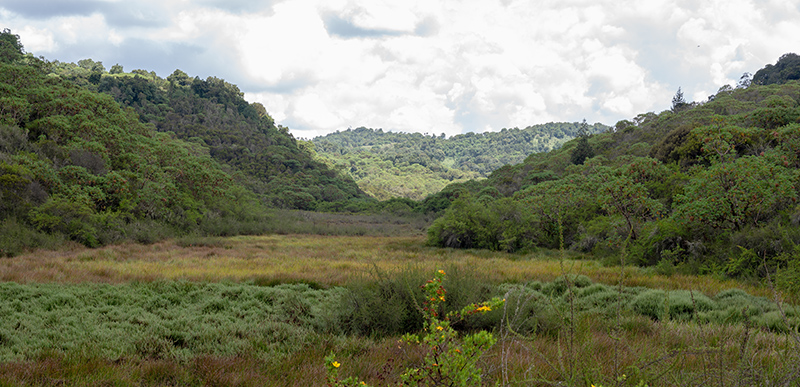
Dorothee draws my attention to a tree with a broad crown and pinnate leaves, the Koso tree (Hagenia abyssinica), characteristic of this area, called Umugeshi in Kinyarwanda.
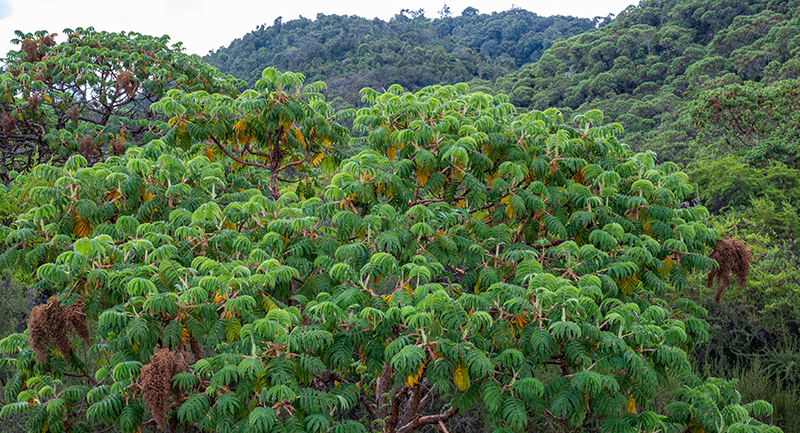
The first orchid I see here is an old acquaintance: I had already met Cynorkis anacamptoides three years ago on a trail at Kamiranzovu Swamp. The terrestrial, i.e. growing on the ground and not on trees, orchid with its only slightly opening flowers is the most common orchid species in Nyungwe. It is also widespread elsewhere in tropical Africa, from Nigeria to Zimbabwe.
After arriving at the Welcome Center in Uwinka, we first have to pass a Corona rapid test. But then we can start on the Igishigishigi Trail to the suspension bridge with the Canopy Walk. For our first botanical destination we don't have to walk long, then we see Wohlleben's mahogany, Carapa wohllebenii.
This is a special moment for Peter Wohlleben and his family, but also for Dorothee, Burkhard and Eberhard, who named the tree after him.
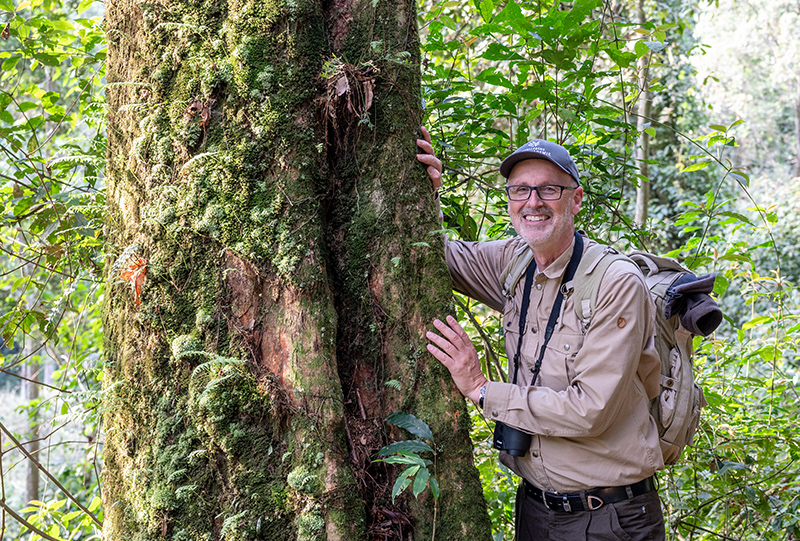
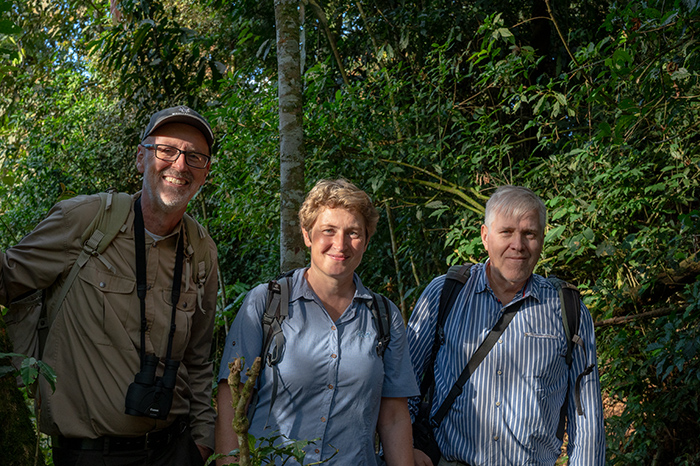
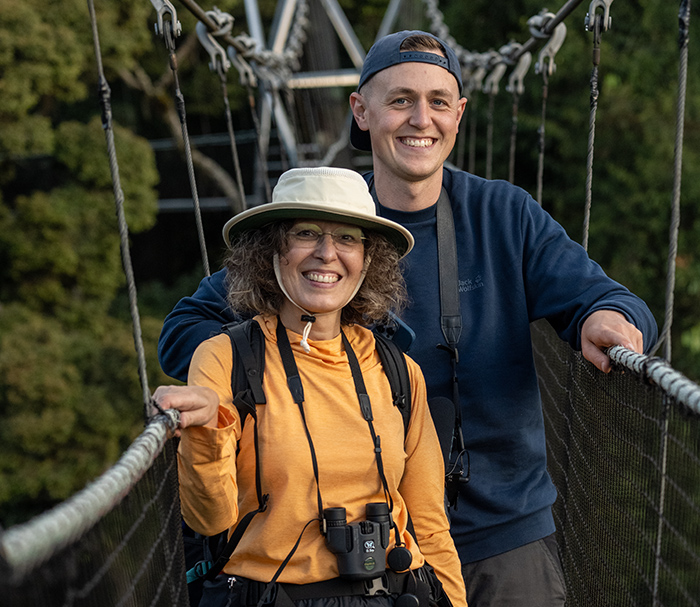
The giant trees are a world apart, each not only a species of tree but also a biotope for countless epiphytic plants. But there are also fascinating plants on the ground. At the wayside there is Cynorkis anacamptoides again. Then I am especially captivated by the snapweeds. An important element of the African flora, which is also well represented in the Albertine Rift, is the species-rich herb genus Impatiens," write Eberhard Fischer, Stefan Abrahamczyk, Norbert Holstein, and Steven B. Janssens in a paper published in September 2021 on the evolution of Impatiens in the Great African Rift Valley in the journal Taxon. Of the approximately 1200 species of the genus worldwide, just over 130 are native to Africa. On the serpentine path leading downward, we first encounter Impatiens burtonii, which is widespread from Cameroon to Ethiopia.
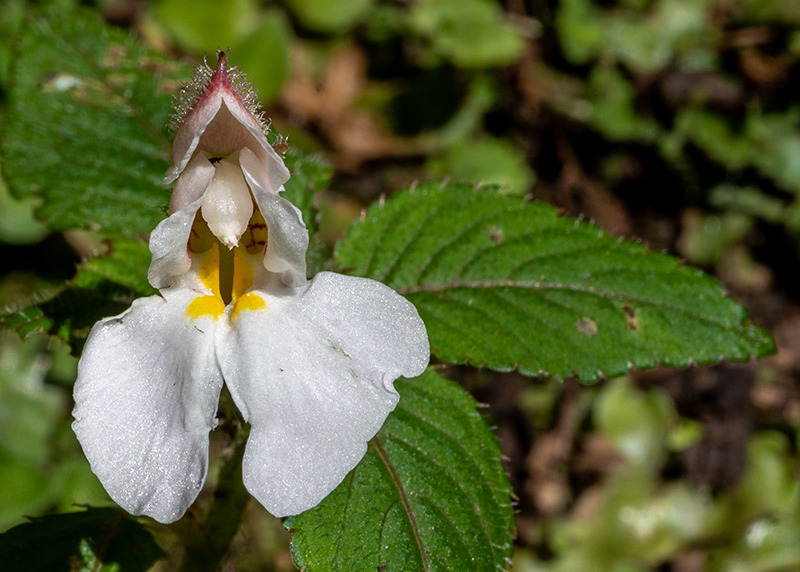
An endemic species in the Albertine Rift is Impatiens purpuro-violacea, which was discovered in 1907 on an expedition by Johannes Mildbraed (1879-1954). In the account of the botanical results he stated: A very distinguished species by its peculiar pubescence and completely inrolled spur. Yes - this is very visible.
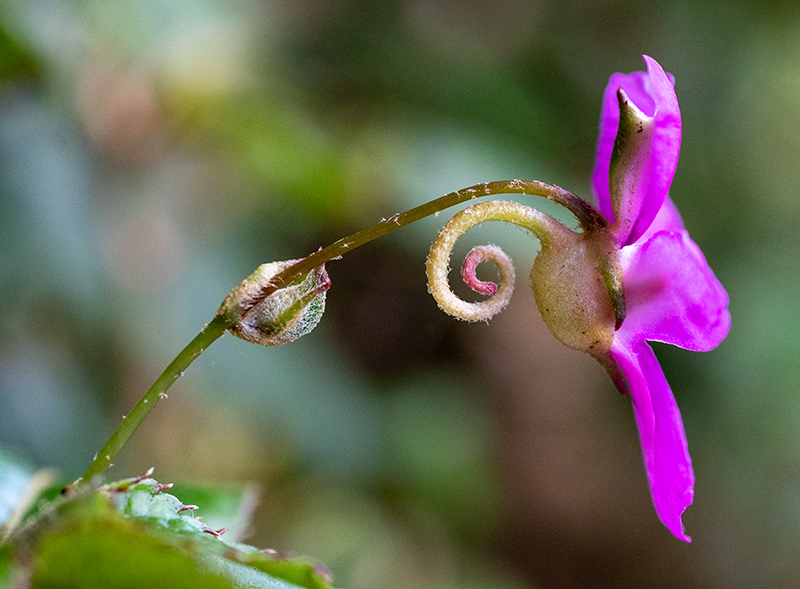
The third species in this day's Impatiens roundup is Impatiens niamniamensis, which is not pollinated by insects but by nectar birds. The plant, which is widespread from Cameroon to Kenya, recalls in its name the ethnic group of the Niam-Niam or Azandeh in the Congo, whose members were said to be cannibalistic. Eberhard explains that there could be a new taxonomic decision on this plant, however.
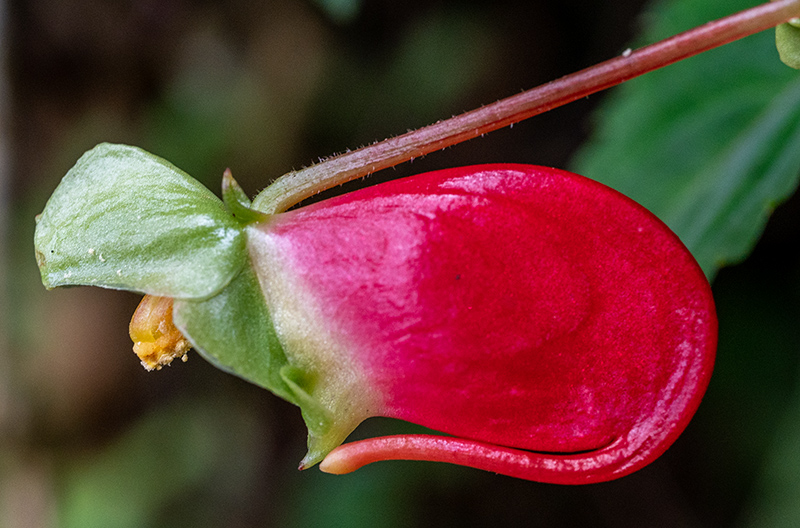
What is blooming so small and deep blue on the ground? That's the smallest of all Lobelia, Dorothee answers. Its tiny size is also expressed in its scientific name: Lobelia minutula.

Again and again I look up into the trees in search of orchids. September is not the best time to bloom, says Eberhard, who notices my glance. But then I discover a special orchid on the suspension bridge: Numerous mustard-yellow flowers of Polystachya spatella stretch out on hanging narrow leaves towards the now slowly fading light.
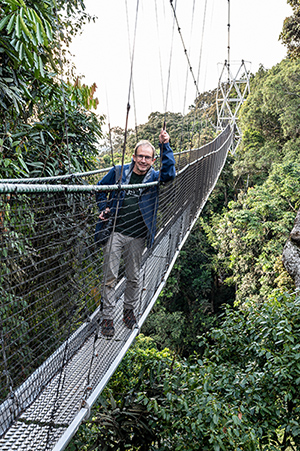 Up to now, the Nikon Z 6 with the macro lens 50/2.8 was mainly used, but now I am grateful that the Z 7 II with the 100-400mm telephoto lens closes the distance to the orchid on the tree for me. Because the bridge is constantly swaying, I choose a fast shutter speed of 1/550 second, and for light sensitivity I have to go up to ISO 2000. The aperture is limited to 5.6, but still lets through enough light.
Up to now, the Nikon Z 6 with the macro lens 50/2.8 was mainly used, but now I am grateful that the Z 7 II with the 100-400mm telephoto lens closes the distance to the orchid on the tree for me. Because the bridge is constantly swaying, I choose a fast shutter speed of 1/550 second, and for light sensitivity I have to go up to ISO 2000. The aperture is limited to 5.6, but still lets through enough light.
An orchid from another genus thrives on a thick branch. It sprouts buds, but must remain undetermined for the time being.
Night falls quickly, we have to go back to the Welcome Center Uwinka. On the way back a thunderstorm breaks over us. The call of the turaco sounds almost mystical.
The last view of the day over the Nyungwe heights to Lake Kivu remains unforgettable.
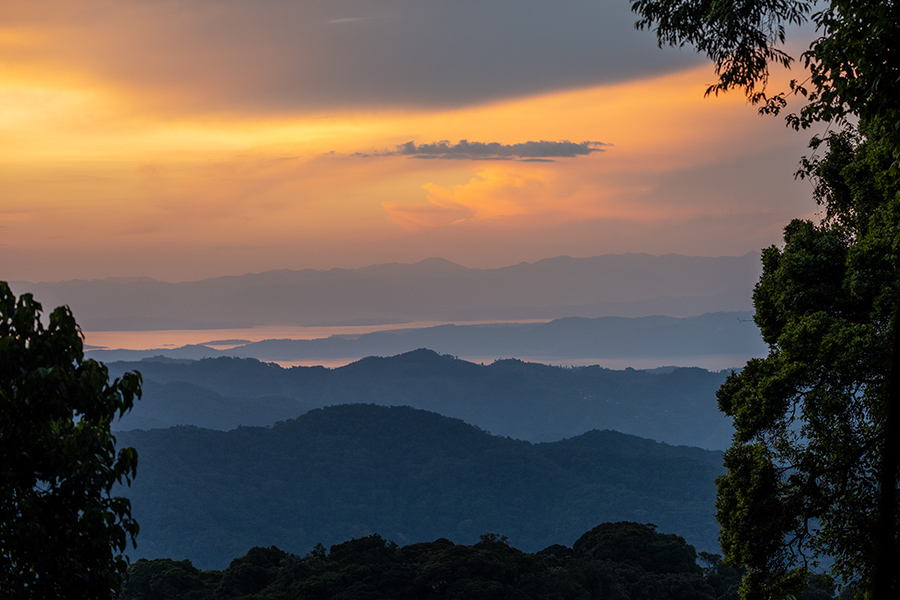
on the Disa slope
Then on October 6 we are on the road again between Uwinka and Kamiranzovu Swamp to see the terrestrial orchid Disa eminii. Its bright pink-red color can be seen from far away.
Also growing on the ground is Satyrium crassicaule, which I had seen blooming three years ago. Here it is still budding.

The orchid view always goes upward in the Nyungwe. And so I see on one of the jungle giants also a plant sprouting in all directions with leaves that are conspicuously notched at the tips. This is the greenish flowering Rhipidoglossum rutilum with a distribution area from West Africa to Mozambique. If you look closer, you can also see buds.
On the drive to Lake Kivu the day is coming to an end and we get to see one more special primate, L'Hoest's monkey (Allochrocebus lhoesti).

A Red Duiker also jumps up at the roadside. As a ruminant, the small antelope feeds on leaves, flowers and fruits. The scientific name Cephalophus natalensis indicates its orignis are in the South African province of KwaZulu-Natal.
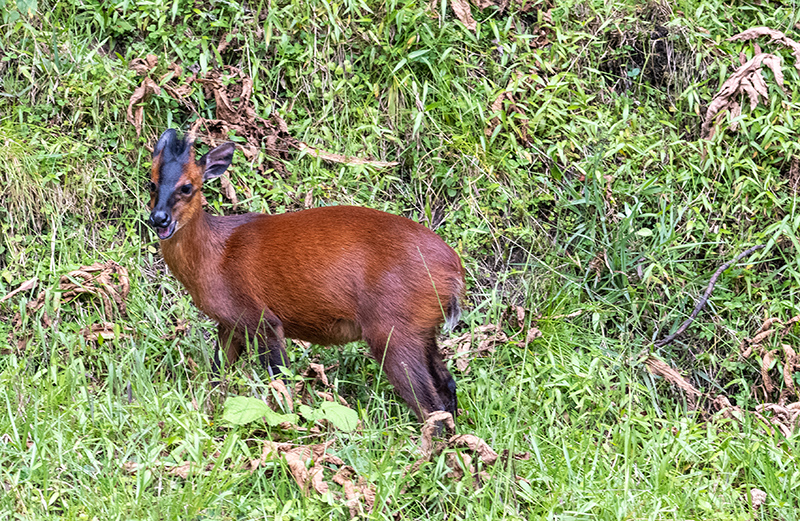
Gisakura
After breakfast at Dushumyumikiza, we drive to Gisakura, the western welcome center of Nyungwe National Park. From there we drive a few kilometers into the tea plantations, to the edge of the rainforest. A farm worker looks at us curiously, then allows me to take her picture.
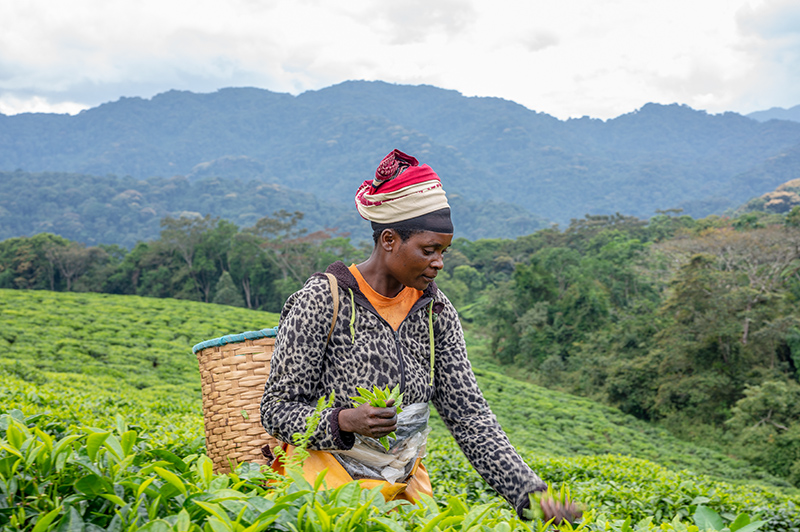
Eberhard directs our gaze to a special sage, Brillantaisia nitens, at the edge of the forest. He demonstrates the special pollination mechanism of the flowers: when a bee settles on the lip, the flower narrows and the pollinator is pressed against the pollen.
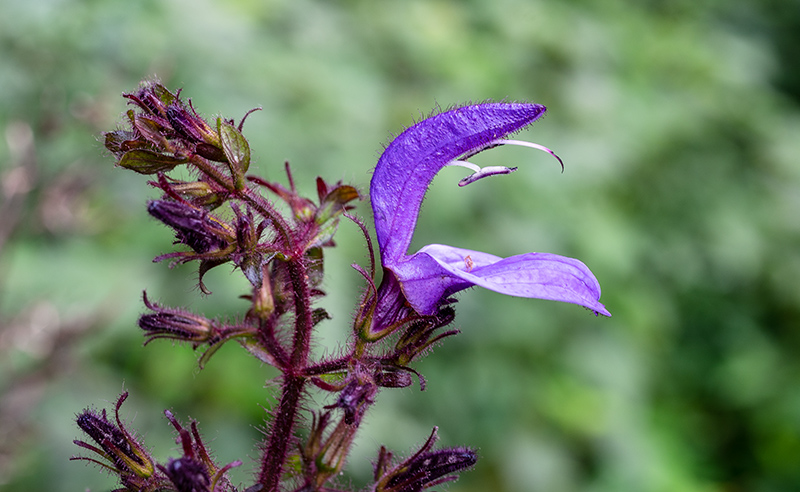
As soon as we enter the rainforest from the tea plantation, high humidity surrounds us - the western edge of Nyungwe is clearly more humid than the east. Dorothee draws our attention to a special skin fern that has laid itself like a carpet on a tree trunk. It belongs to the genus Hymenophyllum, which is also present in the family name of the skin ferns: Hymenophyllaceae.
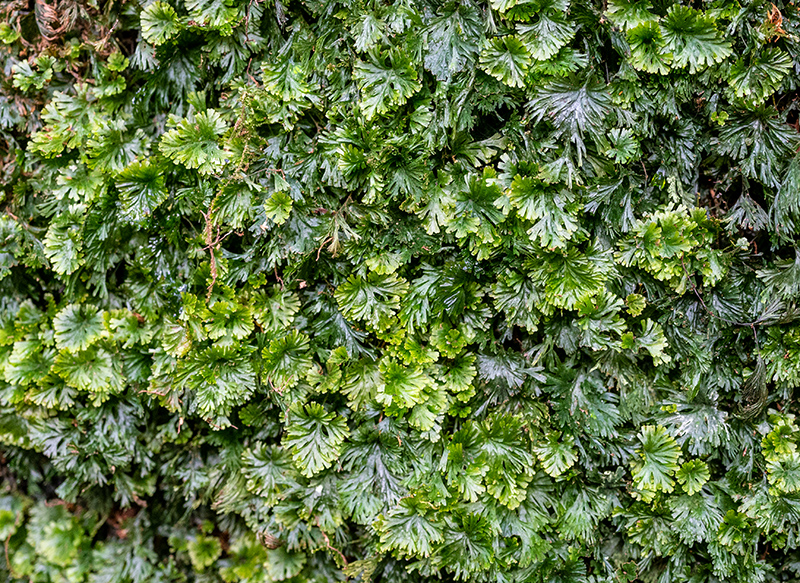
The trail to the waterfalls of Isumo, the Waterfall Trail, invites us to continue our Impatiens studies. First there is Impatiens bequaertii, an endemic of the Albertine Rift, at home between Uganda and Burundi. The plant owes its popular name "dancing girl" to its characteristic flower shape.
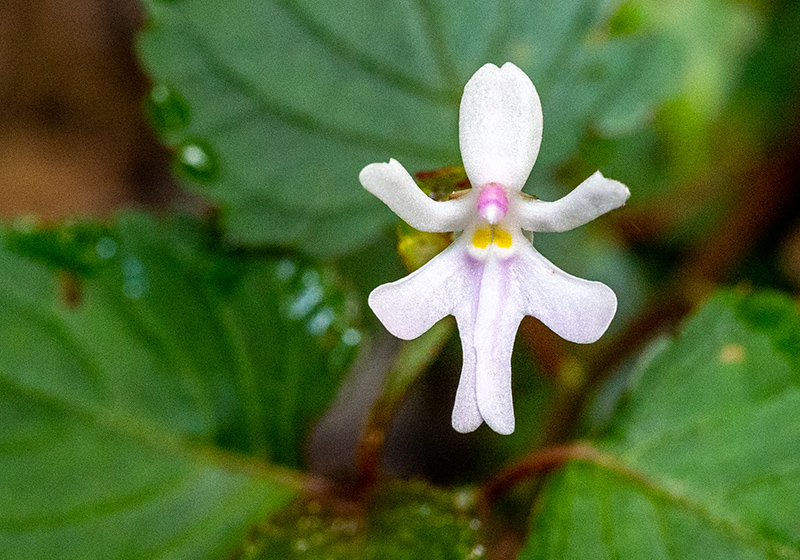
And then there is Impatiens ludewigii, related to Impatiens purpuroviolacea, only described in 2021 by Eberhard Fischer et al. and named after the Chancellor of the University of Koblenz, Michael Ludewig.
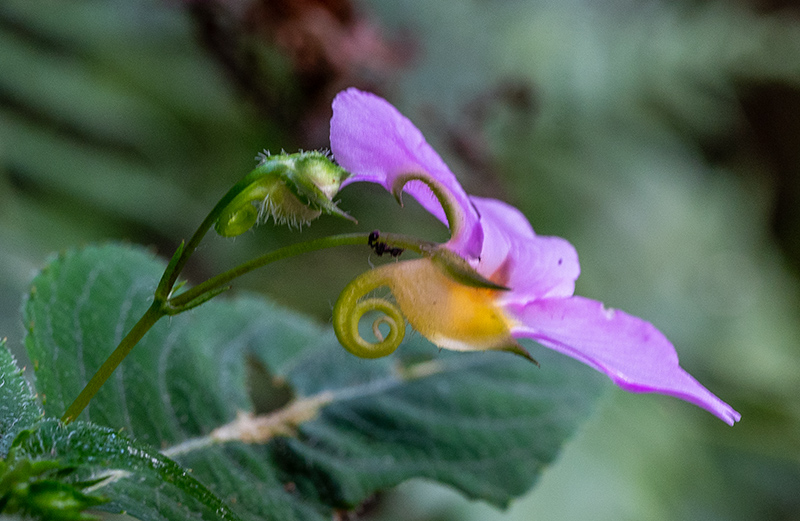
The deeper the path leads us to the valley floor, the more often we encounter Impatiens stuhlmannii with bright flowers.
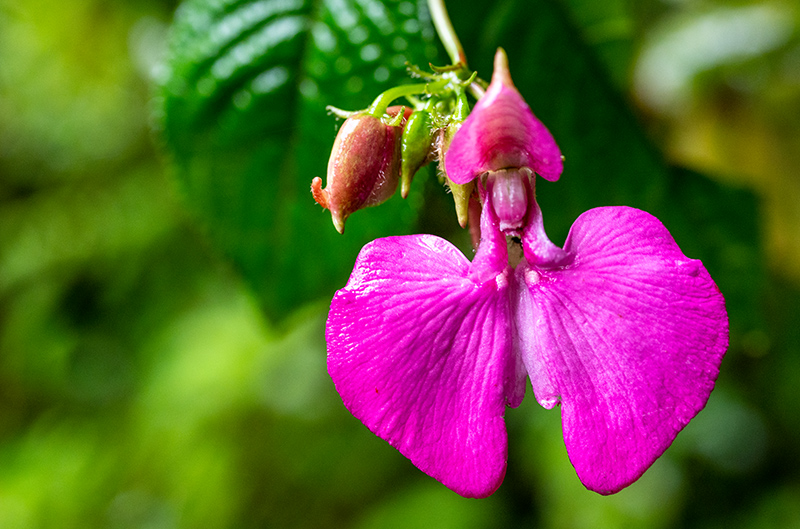
Other rainforest beauties are Begonia - with 1800 to 2000 species in Africa, Asia and America, depending on the delimitation, this is a very species-rich genus. Begonia meyeri-johannis has quite a wide distribution from the Congo to Kenya, Tanzania and Malawi. It is the only climbing begonia species in Rwanda. Male flowers have four petals, female have two to four petals.
Begonia pulcherrima carries the beauty already in its name. The yellow flowering plant is an endemic from the Nyungwe and the adjacent rainforest in Burundi.
As with many Begonia, there are male flowers (above) with about 20 stamens and female flowers with three or four styles. The species was described in 1992 by Dutch botanist Marc Simon Maria Sosef, who has studied the genus, which consists of 900 to 1400 species, in detail. He noted that most begonia species are at home in the more or less shady undergrowth of tropical rainforests and have adapted to these particular conditions.
At the bottom of the valley we finally reach the Isumo waterfall. In the humid air there is lush vegetation with ferns and numerous Impatiens stuhlmannii.
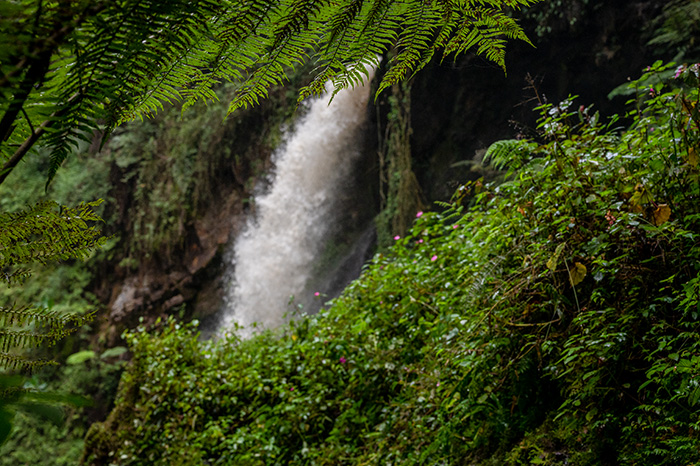
During the ascent, a thunderstorm surprises us with abundant rain and a magical sound backdrop.
In the growing twilight, the view goes upwards, to branches with countless ferns and orchids, whose outlines stand out from the sky like silhouettes.
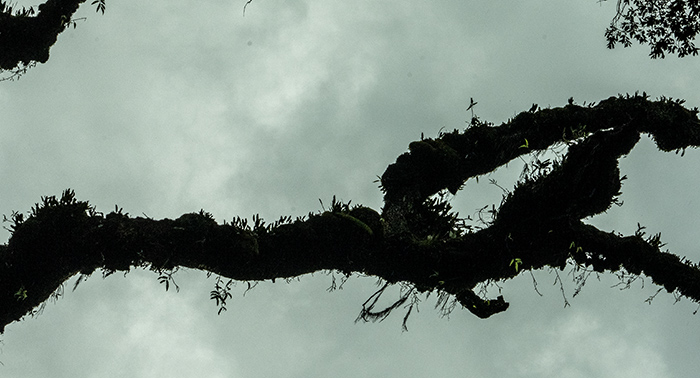
in the Jacaranda tree
On October 6, we are once again on the western Nyungwe rim near Gisakura. We drive on small dirt roads and pass a lively colony of monkeys.

 At the edge of a tea plantation we reach a row of old Jacaranda trees overgrown with ferns and orchids. I follow the example of the monkeys and climb up to have a close look at the plants. In a short time we note eleven different species, many also flowering. Among them are seven species of the genus Polystachya alone.
At the edge of a tea plantation we reach a row of old Jacaranda trees overgrown with ferns and orchids. I follow the example of the monkeys and climb up to have a close look at the plants. In a short time we note eleven different species, many also flowering. Among them are seven species of the genus Polystachya alone.
Polystachya andansoniae is in full flower. The large inflorescence is densely covered with numerous individual flowers, whitish-yellow, with reddish-brown, downward lip tips.
In contrast, Polystachya fallax, an endemic orchid of the region between Burundi, Rwanda, eastern Congo and western Uganda, has large single flowers. It blooms white to yellowish, with a dark red gymnostemium.
Polystachya aconitiflora has very small flowers, light pink to red. It too is endemic to the region and otherwise found only in eastern Congo and western Uganda.
With significantly larger flowers than Polystachya aconitiflora and also otherwise clearly distinguishable is Polystachya vulcanica, another endemic of the region. The cream-colored flowers have pink accents on the lip and at the tip of the gymnostemium.
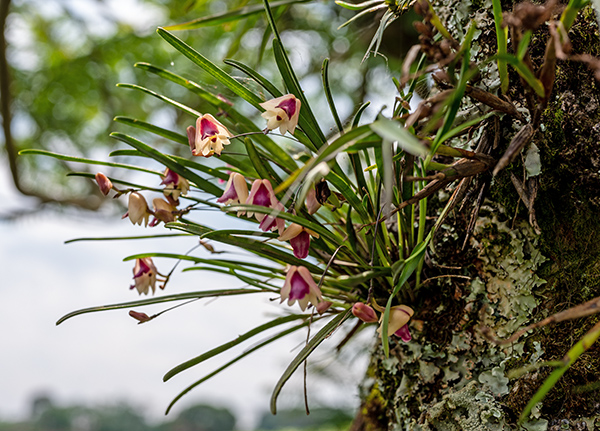
Vertically on the tree trunk, Tridactyle species such as Tridactyle eggelingii also grow among mosses and lichens.
Polystachya spatella is also among the rich Polystachya flora of the Jacaranda trees, which I can now look at more closely than before at Uwinka.
Polystachya tridentata, another endemic of the Albertine Rift, has particularly large flowers that are finely hairy.
No longer flowering is Polystachya mauritiana, which is more widespread in tropical Africa, from Guinea to Ethiopia and Zimbabwe. It has greenish-white very small flowers. Here we can look at the fruits.
Gisovu
On October 5, we drive over dusty dirt roads from Peace Guest House in Cyangugu to the northern edge of Nyungwe. Children play barefoot on the road, a mother breastfeeds her baby in front of the mud house. Near the village of Gisovu is a station of the Rwanda Development Board (RDB). There, Eberhard and Dorothee talk with the management of the national park about joint conservation and research projects. In the meantime I walk a path into the rainforest. Near here is the Nile spring discovered by Richard Kandt. On my way, villagers are on their way to the market on heavily loaded bicycles. At first I pass tall Eucalyptus trees. But then I dive into the rainforest flora, with epiphytic ferns like Pleopeltis macrocarpa growing on almost every tree. Rather rare is the fine Asplenium theciferum.


Orchids also feel at home here like this Polystachya, which has not yet formed flowers:
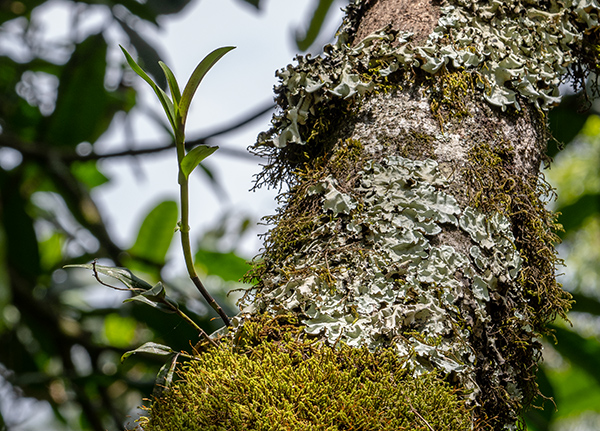
Recognizable by its leaves is Rhipidoglossum bilobatum. Also native to Burundi, eastern Congo, Uganda and Kenya, this orchid has stout, fleshy leaves on a long stem. Its flowers can be seen from January and are greenish-white.
In another tree I discover Tridactyle virgula, which I already know from the garden in Butare and experienced in most beautiful bloom. Here only buds are formed.
Finally I have to turn back to be meet the group at the agreed time. On a meager meadow I still see Cynorkis anacamptoides, certainly the most common terrestrial orchid in Nyungwe. Much larger than the European Polygala species, familiar companions on many orchid explorations, is Polygala ruwenzoriensis.
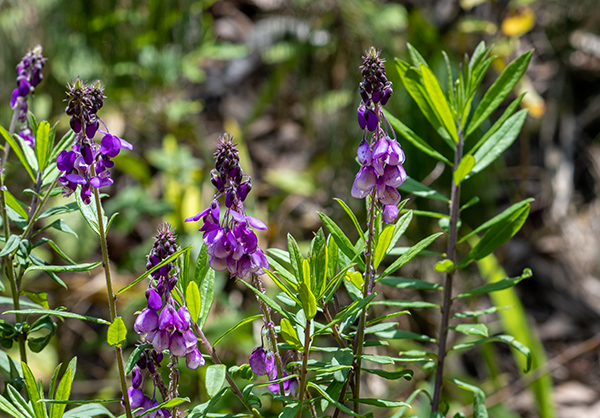
Finally, Eberhard draws my attention to Coccinia mildbraedii, which belongs to the cucurbits. Cylindrical fruits, which are first bright, and finally bright red, develop on the inflorescence of the pretty, bell-like flower. The species is named after the botanist Johannes Mildbraed (1879-1954), who in 1907 took part in the expedition led by Adolf Friedrich zu Mecklenburg, which also led to the Nyungwe.
Still slightly west of the Nyungwe is the rainforest of Cyamudongo. The 19 square kilometer area, with a sea level of 1900 meters somewhat lower than the Nyungwe, was originally connected to it, but was then isolated from it - the land in between was cleared and used for agriculture. Thanks to its steep slopes, the Cyamudongo forest was preserved. The permanent protection of the area was the goal of an agroforestry project of the University of Koblenz-Landau with the seeding of trees in the marginal zones.


We walk along the same path on October 6 as farm workers hauling heavy sacks. Like the many butterflies, we are mainly interested in flowering plants. The flowers of a species of Impatiens, which probably belongs to the group of Impatiens stuhlmannii but is smaller and more intensely colored, have intense pink colors. The plant produces many flowers and attracts butterflies.
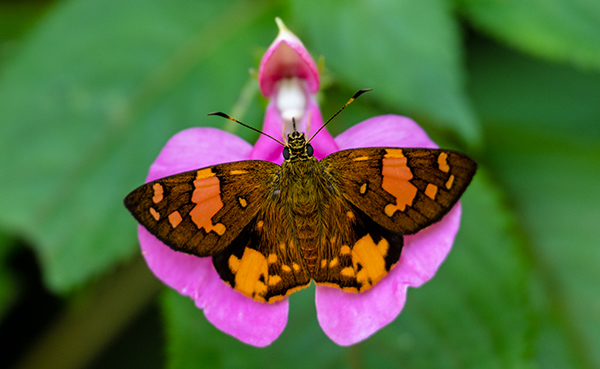
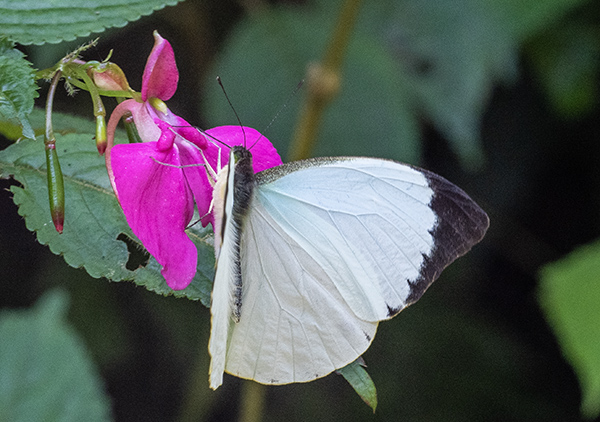
But our eyes also go up again and again. Hardly a trunk without orchids or epiphytic ferns.
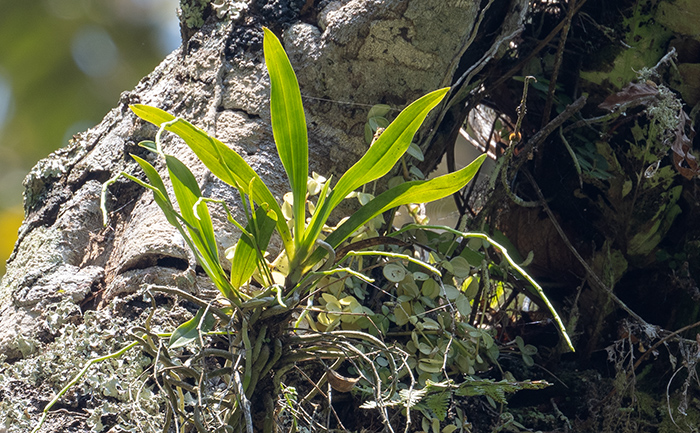
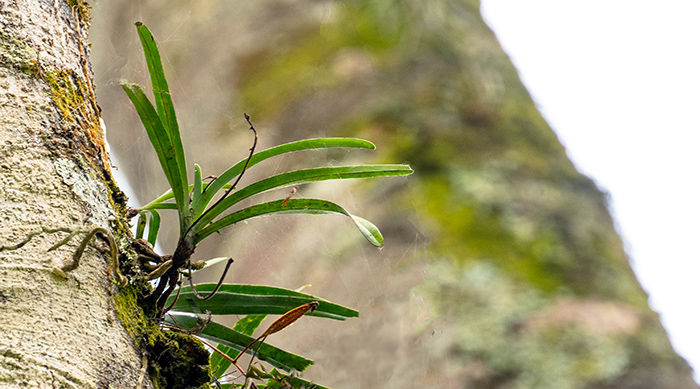
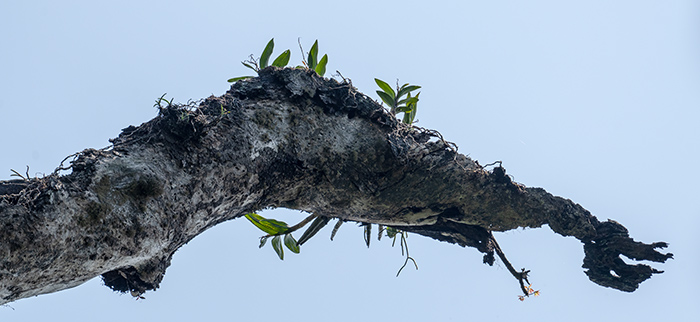
In more detail we look at the mahogany trees. Here grows not only Carapa wohllebenii with its pointed leaves, but also the first described Carapa grandiflora with roundish leaves.
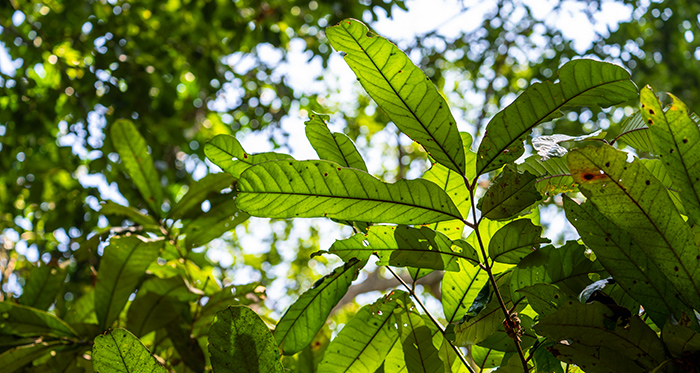
Eberhard draws my attention to the African pepper, Piper capense. The fruits taste pleasantly peppery. The plant, which is widespread from eastern Congo to South Africa, has a special significance in traditional African medicine. It has now been proven that the fruits can curb the growth of cancer cells.
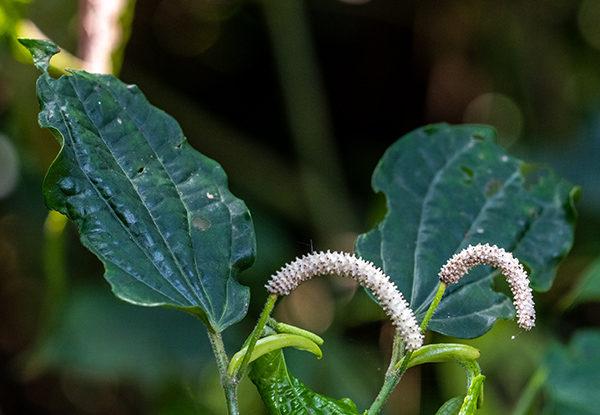
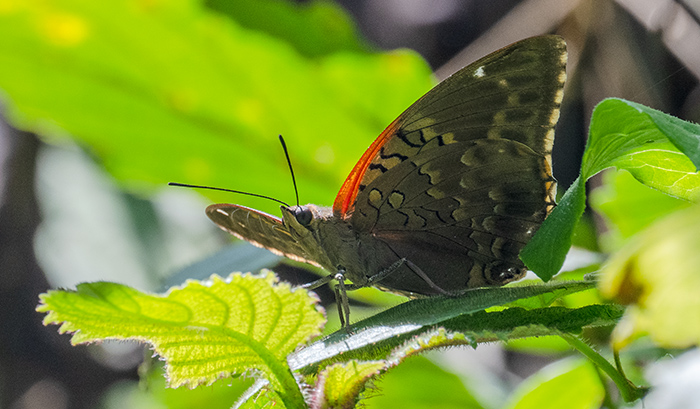
We immerse ourselves in a tropical soundscape, with a reverent sense of urgency to preserve this special habitat.
Then we see a flowering orchid in a tree, with many white flowers and a long curved spur - this is Angraecopsis gracillima.
And then, high up in the branches, Burkhard sees an orchid previously known only from Cyamudongo! Dorothee, Eberhard and Jean-Paul Lebel described the endemic Polystachya bruechertiae in 2009 (Fischer, Eberhard/Killmann, Dorothee/Lebel, Jean-Paul: Polystachya bruechertiae, a new species from Cyamudongo Forest, Rwanda. In: The Orchid 60, 2009. p. 105-113).
The trio of authors reports: During research in the Cyamudongo Forest, now part of Nyungwe National Park, a very conspicuous polystachya was discovered on a fallen branch. The description indicates among other observations: Flowers with greenish sepals, downy hairy outside, purple nerves inside, petals greenish, lip yellowish-green, with distinct purple nerves, callus yellow, hairy, midlobe of lip uniformly purple-violet. The purple lip can also be clearly seen from the ground on several plants at height. The name honors the teacher Alexandra Brüchert from Rockenhausen in the Donnersberg district of northern Palatinate, Germany.
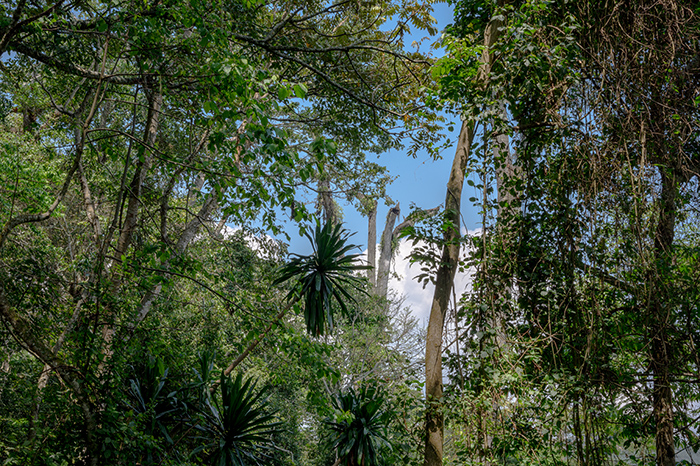
Lake Kivu stretches between Nyungwe in the southwest of Rwanda and the Volcanoes National Park in the northwest. In the middle of the East African Rift Valley, the border between Rwanda and Congo runs through the middle of the lake. With an area of 2400 square meters, it is four times the size of Lake Constance. With a depth of 480 meters, it is remarkable that the water temperature rises with increasing depth - this is caused by volcanic springs.
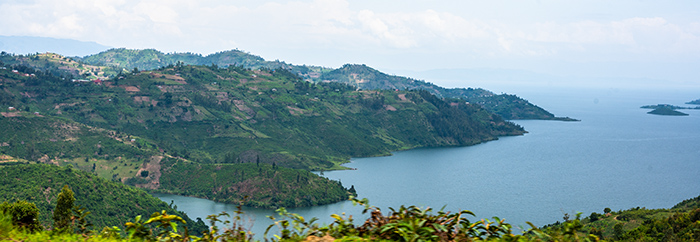
ein Morgen am See
At Peace Guest House in Cyangugu, right on the shore of Lake Kivu, I am awakened early in the morning of September 27 by the characteristic call of the Tropical Boubou (Laniarius major):
I'll have to see if I can see him in the garden. At least a young Tropical Boubou I discover on a tree.
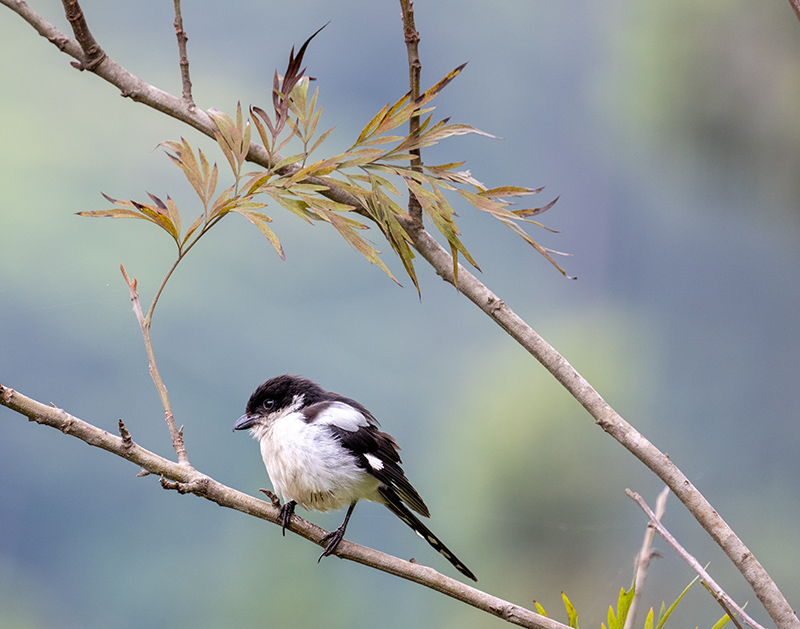
And this is from the same genus probably a young Red-backed Shrike (Lanius collurio):
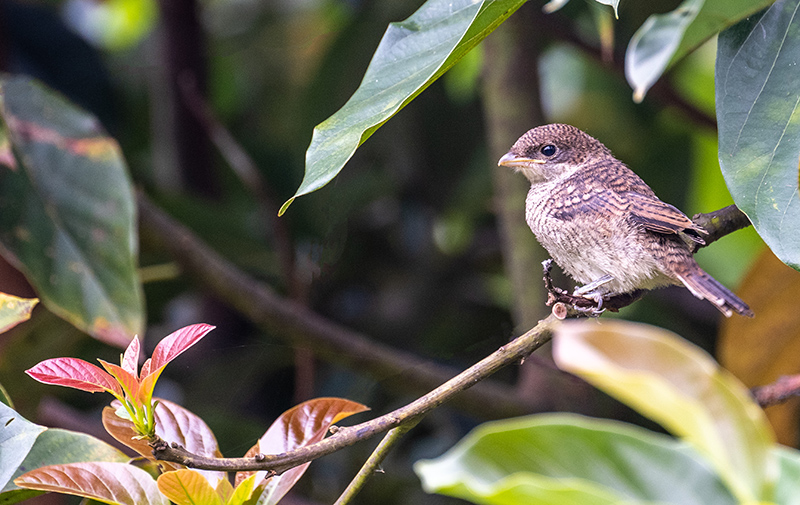
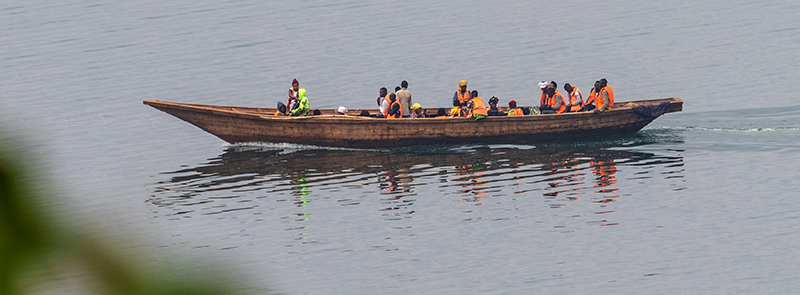
On September 28 we drive north along the east bank of the Kivu and stop at Kibuye. There, on the shore, we have a direct view of Napoleon Island - the island is said to resemble Napoleon's hat.
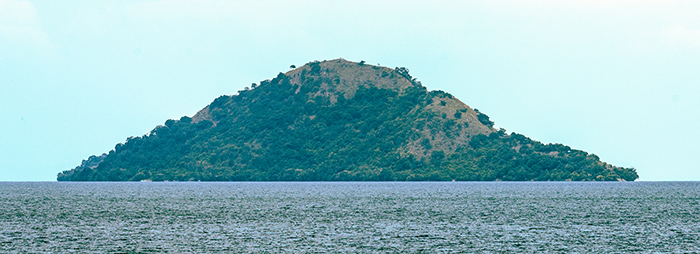
On the shore we see the characteristic bird of Lake Kivu, the Pied Kingfisher (Ceryle rudis).
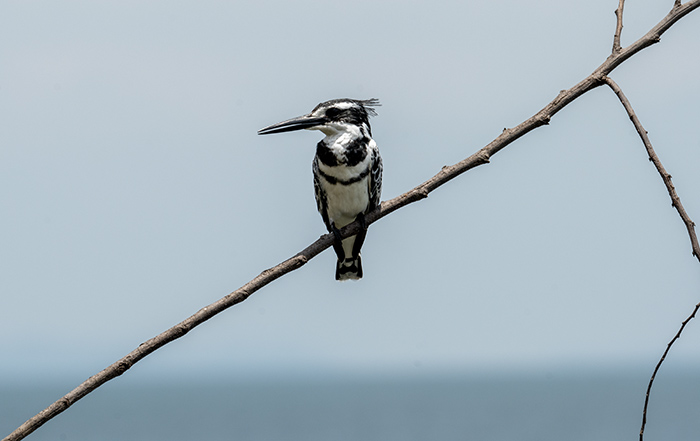
Very lively and not at all shy is the African Pied Wagtail (Motacilla aguimp), which is related to the wagtails. The bird is at home in large parts of Africa south of the Sahara.

We can watch for a while a special nectar bird, whose plumage shimmers in all shades between green and blue. Its dark red breast gives it the English name Red-chested Sunbird (Cinnyris erythrocercus).
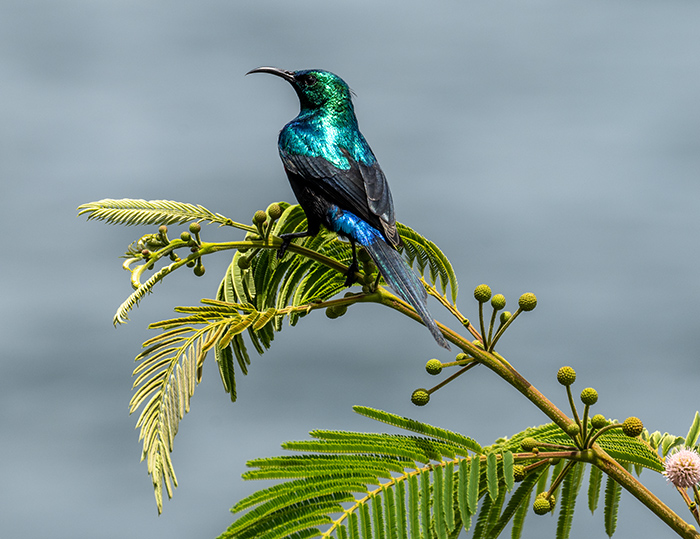
Gishwati-Mukura National Park is the youngest in Rwanda. With an area of 34 square kilometers, it is also significantly smaller than Nyungwe, which lies to the south of it, or Volcanoes Park in the north. It is located on the watershed between the Nile and Congo rivers and ranges in altitude from 2000 to 3000 meters.

We have an appointment with the director of the national park, Ezechiel Turikunkiko, who leads us on a narrow path into the rainforest.
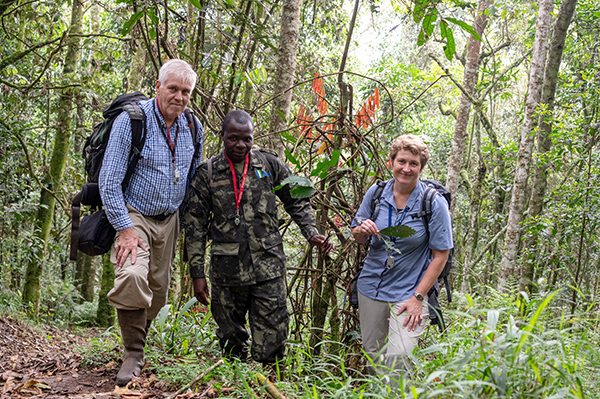
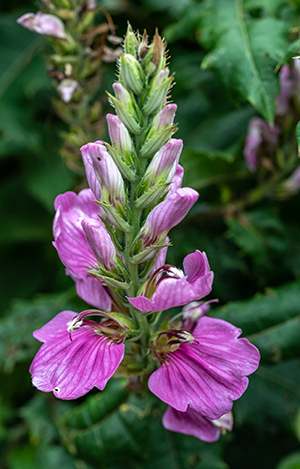
At the upper edge of the forest we see an acanthus plant, Acanthus polystachyus (right). The leaves are used in traditional African medicine against malaria or in case of snakebites, the seeds for treating wounds. As soon as we enter the rainforest, we again encounter Wohlleben's mahogany and Impatiens burtonii, later also Impatiens njamnjamensis.
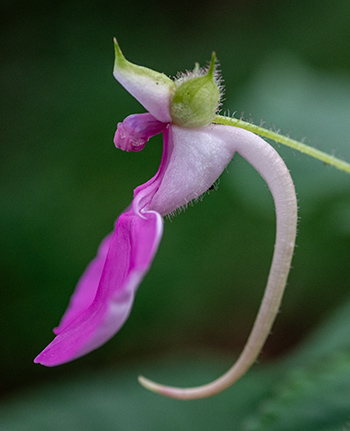 And we study an Impatiens related with Impatiens stuhlmannii, which we are unsure of the identification. The upper helmet-like petal is clearly brighter than in Impatiens stuhlmannii, also brighter than the unknown Impatiens from Cyamudongo Forest.
And we study an Impatiens related with Impatiens stuhlmannii, which we are unsure of the identification. The upper helmet-like petal is clearly brighter than in Impatiens stuhlmannii, also brighter than the unknown Impatiens from Cyamudongo Forest.
But most importantly, we also see special orchids here! A Tridactyle orchid nestles close to the tree trunk.
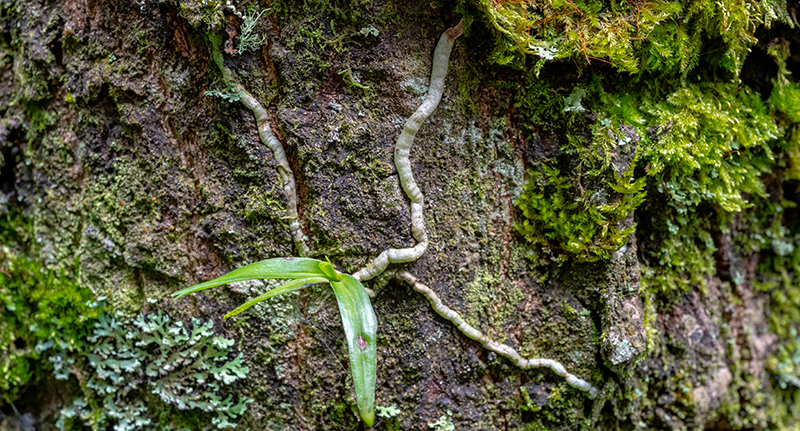
Then we study an Angraecum, previously listed as Angraecum moandense, but here probably a separate species and soon to be described as a new species.
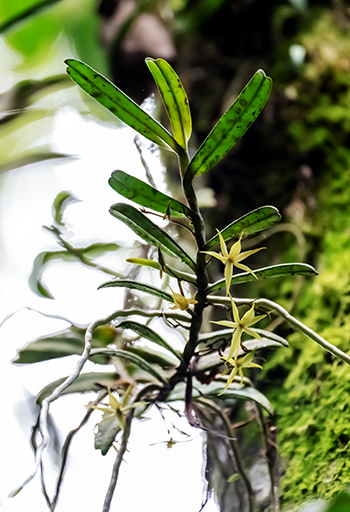
On our way, chimpanzees can be heard briefly. Then we dive again into the Gishwati sound characterized by cicadas.
On a tree grows Liparis epiphytica - the small yellow-greenish flowers with filiform sepals are reminiscent of the Liparis in Europe. The tropical species is distributed from the Ivory Coast to Uganda.
Quite common on our path is a Rhipidoglossum species with long narrow leaves. The plants form straight buds. So far, these plants were considered as Rhipidoglossum globulosocalcaratum, first described in the Congo. But this is a different species, which will be described soon, explains Eberhard.
Other orchids are not yet blooming, but show impressive leaves like Aerangis ugandensis, whose aerial roots are bedded on a bed of moss.
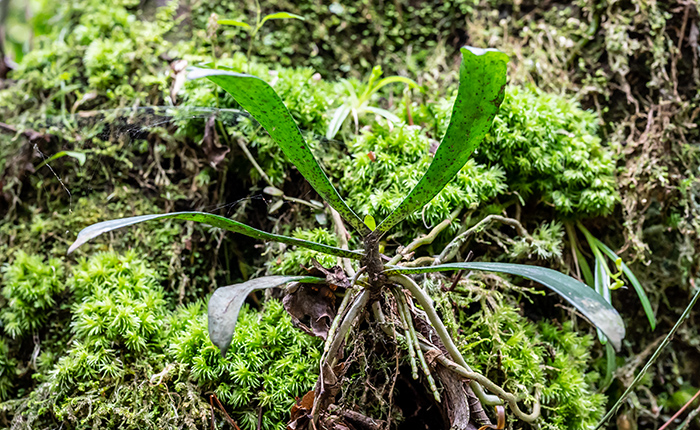
Peperomia fernandopoiana lets its long inflorescences hang down from a mossy branch. It belongs to the pepper family.
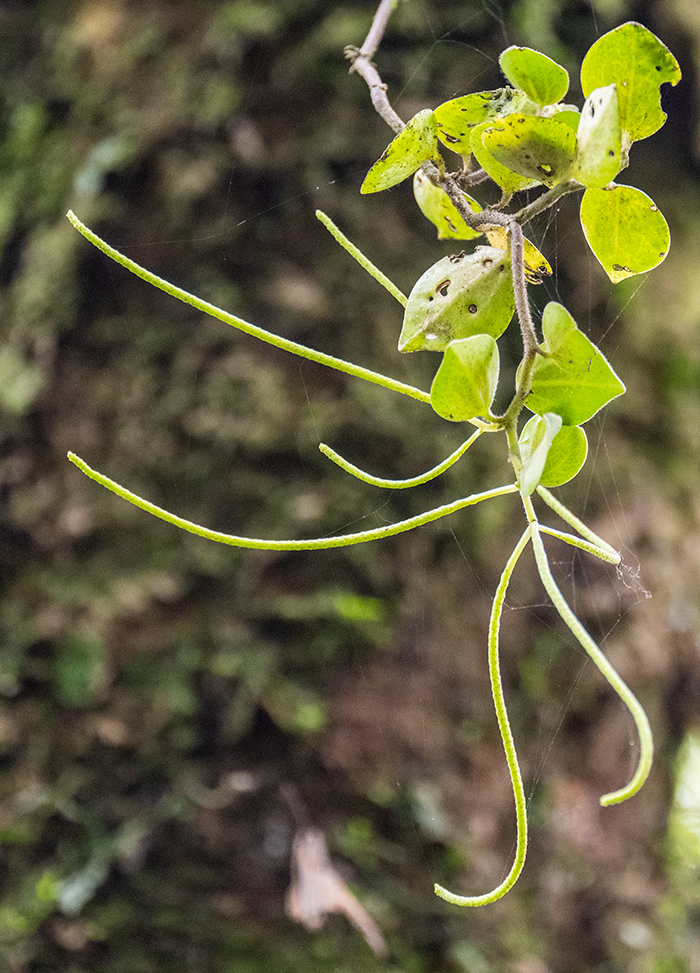
As in Nyungwe, Polystachya adansoniae blooms here, sometimes with a very short inflorescence, sometimes with a longer one.I am impressed by the special leaf shape of a fern, that is Drynaria volkensii. The leaves are used in folk medicine for poisoning.
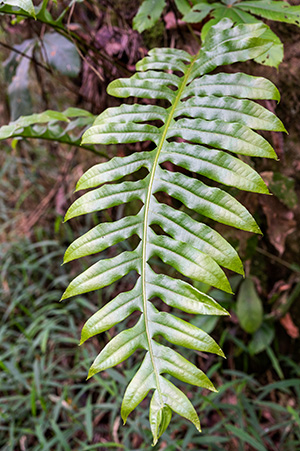
After many special impressions in the Gishwati forest, the day ends in Gisenye with a walk on the shore of Lake Kivu, near the border crossing into Congo, and a special discovery for Eberhard's fern research: the delicate-leaved fern Davallia chaerophylloides grows on a tree - a first find for Rwanda.
We spend the 29th of September in the Volcanoes National Park. Dorothee and Burkhard have decided to visit the mountain gorillas with the Wohlleben family. Eberhard and I want to explore the 3711 meter high volcano Bisoke. We walk with our guide Theo through fields where potatoes and Pyrethrum are grown - the Pyrethrum flowers are used for the production of natural pesticides.

Then we reach the beginning of the national park. A signpost leads us to the explorer trail.
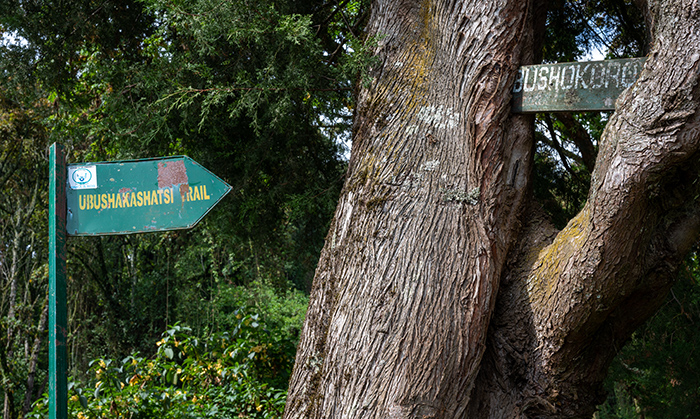
Since it rained heavily the day before, the paths are very muddy. Again and again we slip. It becomes painful when we fall on one of the nasty nettles that line the path. But no pain without nature's antidote! Theo shows me how to apply the milky sap of Lobelia gibberoa to the skin so that the pain quickly subsides.
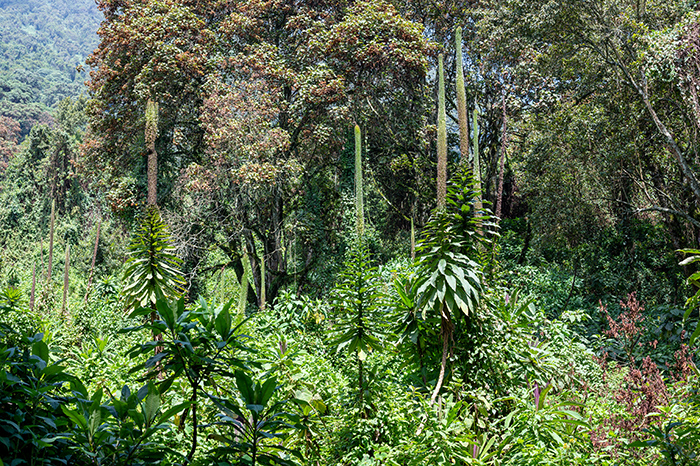
Impatiens burtonii blooms pale purple along the path. And I get to know more and more ferns - Asplenium mildtbraedii with its delicate leaflets and Pteris dentata with light green leaf fronds. On almost every tree grows Pleopeltis macrocarpa, which I already saw a lot in Nyungwe.
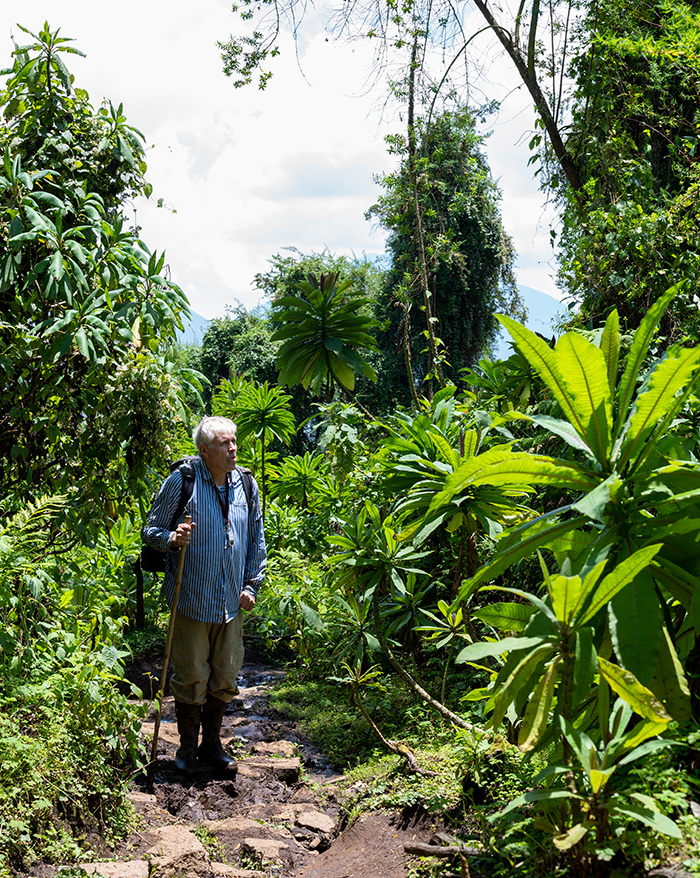
However, we soon realize that we will not make it to the Bisoke summit in one day due to extensive botanizing and especially due to the difficult path. So we take our time now and enjoy the view of Karisimbi (4507 m), the highest of the Virunga volcanoes.
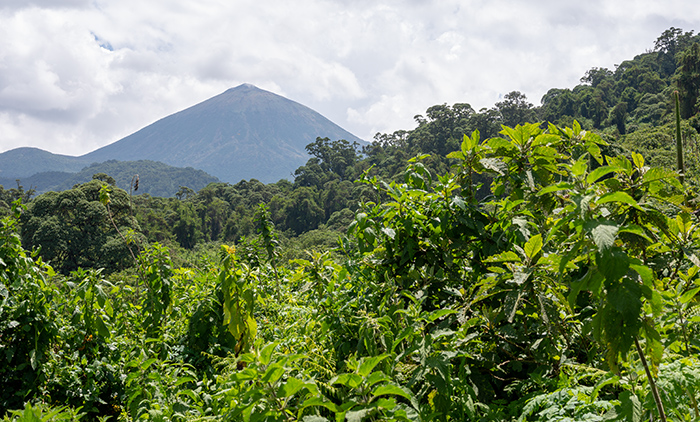 Pink-white flower umbels form the tree Dombeya torrida, which has a wide distribution from eastern Congo to Ethiopia and to South Africa. And together with Hagenia abyssinica, already familiar to me from Nyungwe, Hypericum revolutum forms a characteristic vegetation belt, the Hagenia-Hypericum. I am amazed that this large shrub, growing up to 15 meters high, is related to the European Hypericum perforatum. The yellow flower color, however, is common to both.
Pink-white flower umbels form the tree Dombeya torrida, which has a wide distribution from eastern Congo to Ethiopia and to South Africa. And together with Hagenia abyssinica, already familiar to me from Nyungwe, Hypericum revolutum forms a characteristic vegetation belt, the Hagenia-Hypericum. I am amazed that this large shrub, growing up to 15 meters high, is related to the European Hypericum perforatum. The yellow flower color, however, is common to both.

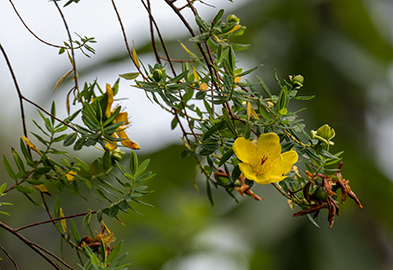
The wild vegetation and the altitude of a good 3000 meters take my breath away. Again and again I look up into the treetops. Even if we do not reach the summit today, I would love to see the red flowering Polystachya kermesina.

With difficulty I climb above the graceful meadow in memory of the gorilla researcher Dian Fossey up a lava field. There I want to look around again and then the descent can begin. Looking down I discover something red at a vertical tree trunk. Since the tree is fully overgrown with lichens, I think first of the fruiting body of a lichen, so small is the structure. But the picture with the telephoto lens shows then but the special orchid!
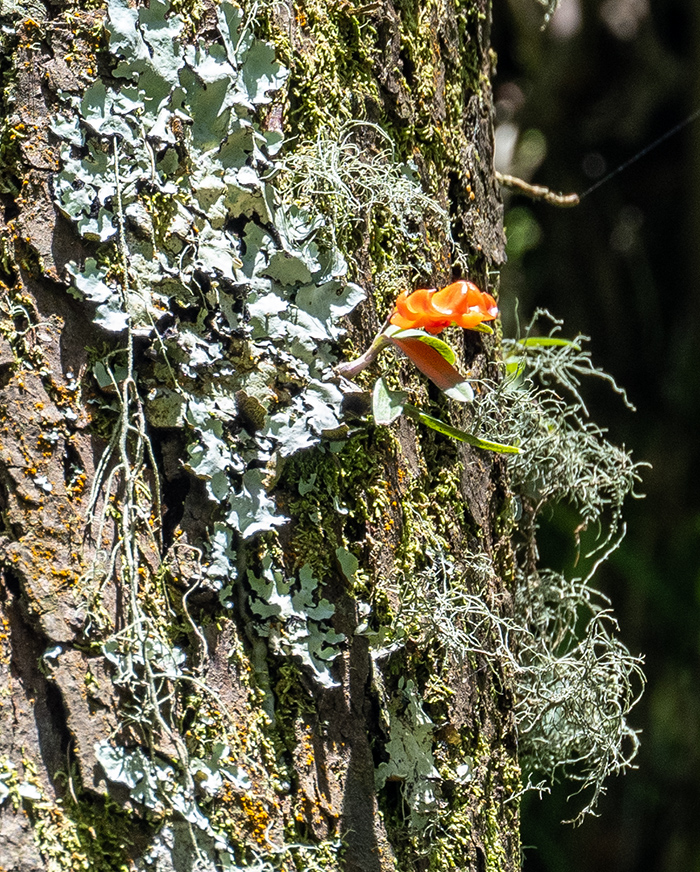

The explorer Friedrich Wilhelm Ludwig Kraenzlin (1847-1934) noted in his description of Polystachya kermesiana: "A small, somewhat shaggy plant, consisting of a dense felt of roots, dead and living stems and leaves, among which are scattered the vividly colored 'lacquer-red' flowers." By Johannes Mildbraed (In: Scientific results of the German Central Africa Expedition, 1907-1908 : led by Adolf Friedrich, Duke of Mecklenburg. Vol. II, p. 75). There is a drawing of the plant:

A study published in 1996 on the epiphytic flora in forests in Rwanda and Congo identified only one orchid for the rainforest in the Volcanoes, Polystachya kermesiana, and attributed the lower species diversity in different plant families to the special altitude. (Biedinger, Nadja/Fischer, Eberhard: Epiphytic vegetation and ecology in Central African forests (Rwanda, Zaïre). In: Ecotropica 2, 1996. p. 121-142).
In the meantime Eberhard has also discovered the fern Asplenium majus we were looking for. We are lucky - according to the description it occurs in the Volcanoes only up from an altitude of 3300 meters. We now see it at about 3000 meters. Eberhard draws my attention to the spore camps on the underside of the leaf fronds.
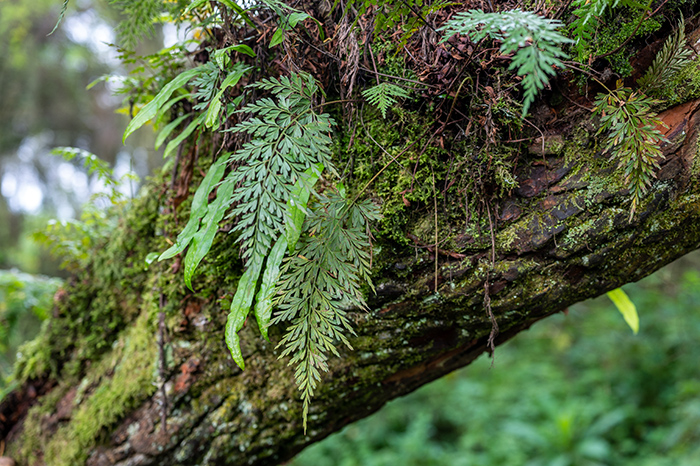
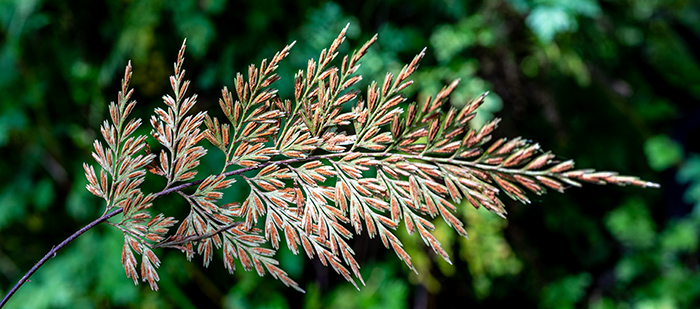
For the descent we then choose another way. Theo draws our attention to a Ruwenzori sun squirrel (Heliosciurus ruwenzorii).
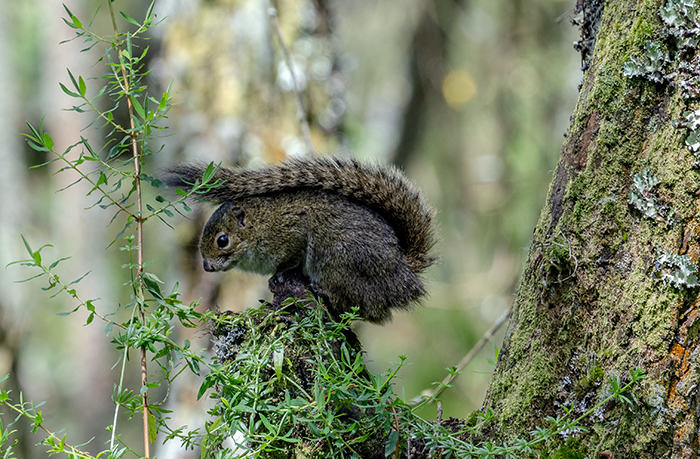
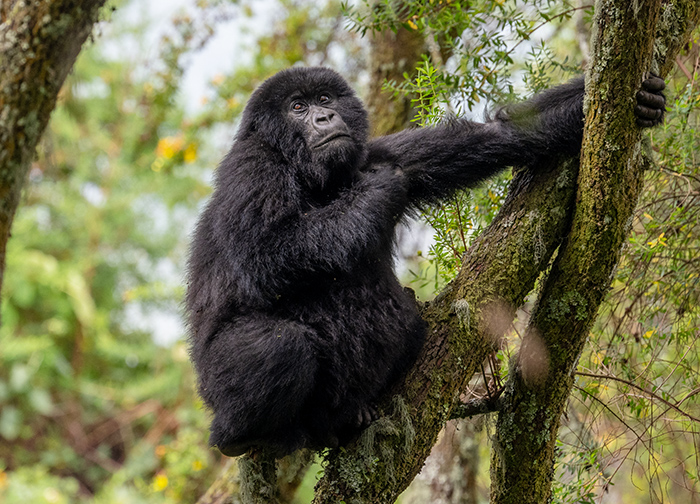
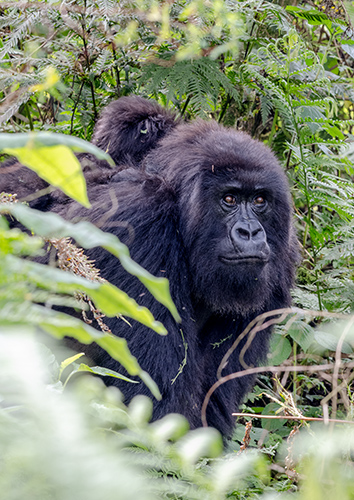
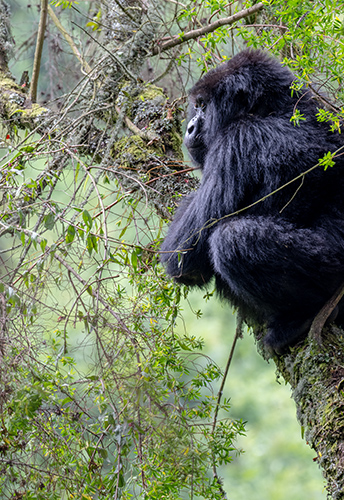
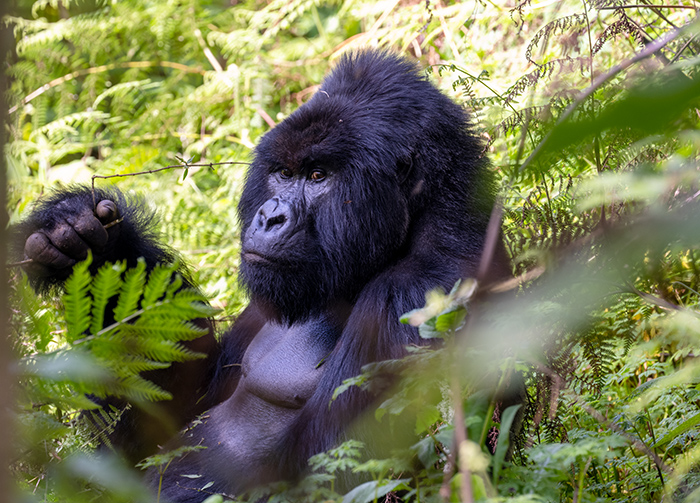
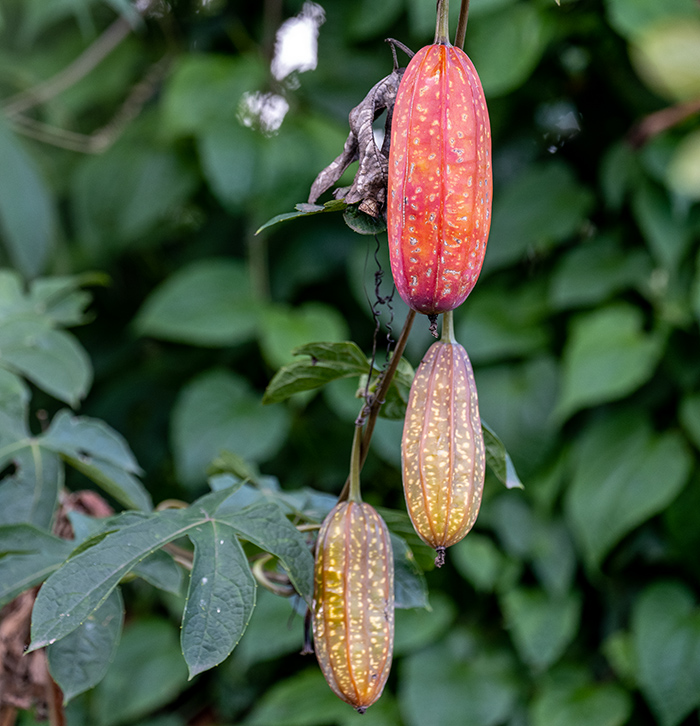
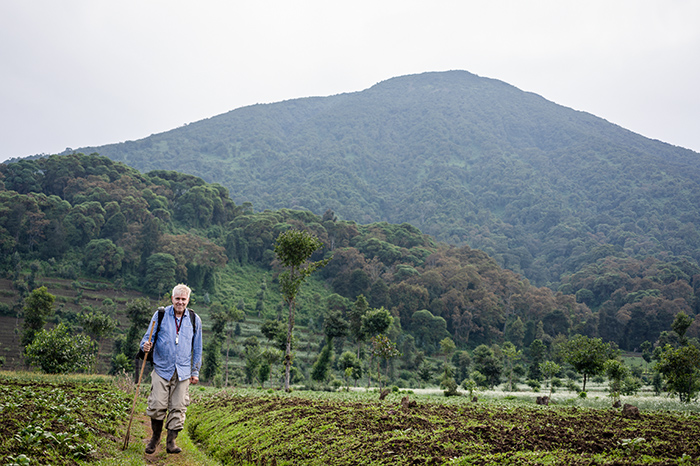
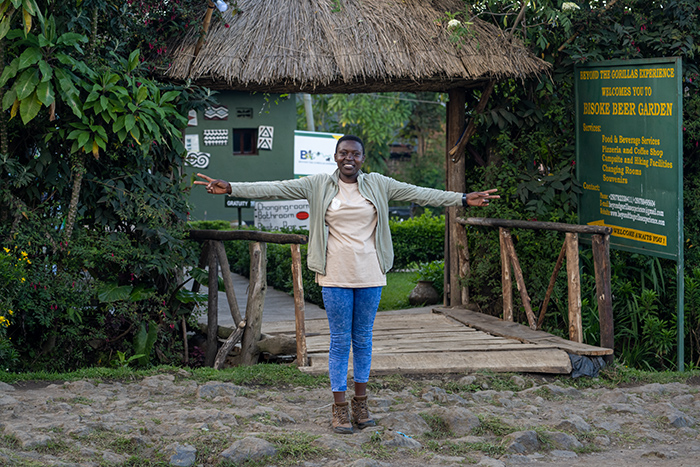
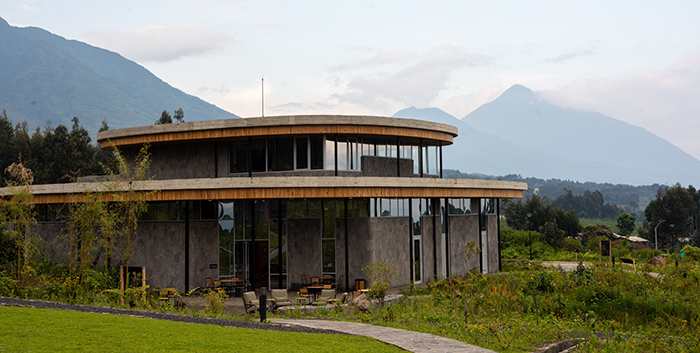
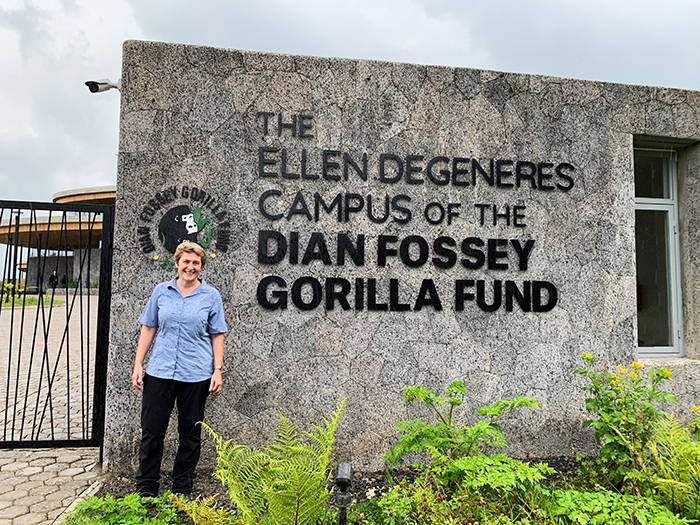
Mentioned species of plants
Orchidaceae
- Aerangis ugandensis
- Angraecopsis gracillima
- Angraecum distichum
- Angraecum spec.
- Ansellia africana
- Bulbophyllum cochleatum var. bequaertii
- Bulbophyllum vulcanicum
- Calyptrochilum christyanum
- Cynorkis anacamptoides
- Cyrtorchis arcuata subsp. whytei
- Diaphananthe lebelii
- Disa eminii
- Liparis epiphytica
- Polystachya aconitiflora
- Polystachya adansoniae
- Polystachya benettiana
- Polystachya bruechertiae
- Polystachya dewanckeliana
- Polystachya fallax
- Polystachya kermesina
- Polystachya mauritiana
- Polystachya pachychila
- Polystachya spatella
- Polystachya tridentata
- Polystachya vulcanica
- Rhipidoglossum bilobatum
- Rhipidoglossum rutilum
- Rhipidoglossum spec.
- Satyrium crassicaule
- Tridactyle eggelingii
- Tridactyle virgula
Acanthaceae
- Acanthus polystachyus
- Brillantaisia nitens
Aspleniaceae
- Asplenium majus
- Asplenium mildbraedii
- Asplenium theciferum
Balsaminaceae
- Impatiens bequaertii
- Impatiens burtonii
- Impatiens ludewigii
- Impatiens niamniamensis
- Impatiens purpuro-violacea
- Impatiens stuhlmannii
- Impatiens spec.
Begoniaceae
- Begonia meyeri-johannis
- Begonia pulcherrima
Bignoniaceae
- Jacaranda mimosifolia
Campanulaceae
- Lobelia gibberoa
- Lobelia minutula
Cucurbitaceae
- Coccinia mildbraedii
Davalliaceae
- Davallia chaerophylloides
Hymenophyllaceae
- Hymenophyllum spec.
Hypericaceae
- Hypericum revolutum
Malvaceae
- Dombeya torrida
- Carapa grandiflora
- Carapa wohllebenii
Piperaceae
- Peperomia fernandopoiana
- Piper capense
Polygalaceae
- Polygala ruwenzoriensis
Polypodiaceae
- Drynaria volkensii
- Pleopeltis macrocarpa
Pteridaceae
- Pteris dentata
Rosacea
- Hagenia abyssinica
